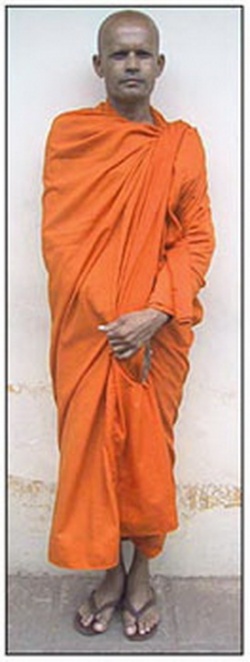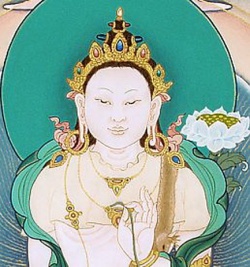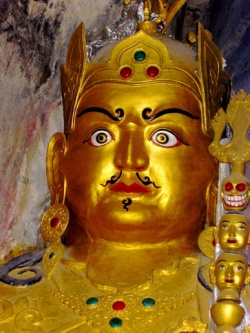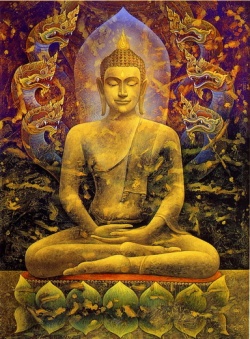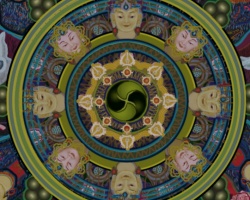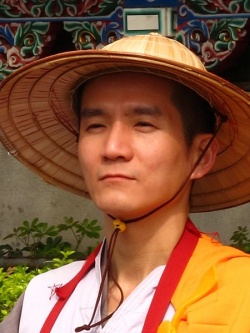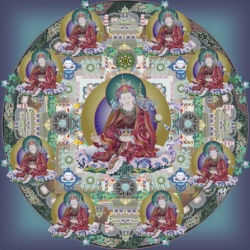Difference between revisions of "Plotinus and Vijnanavada Buddhism"
(Created page with " <poem> By McEvilley, Thomas Philosophy East & West I. AIMS AND SCOPE As A. H. Armstrong has said, and virtually every scholarly commentator on {{Wiki|Pl...") |
|||
| (5 intermediate revisions by 2 users not shown) | |||
| Line 1: | Line 1: | ||
| − | + | {{DisplayImages|1344|985|999|2486|2550|1660|3376|765|1493|3034|922|750|3755|1314|73|3805}}{{DisplayImages|3494|2494|3852|1492|2474|1389}} | |
<poem> | <poem> | ||
By McEvilley, Thomas | By McEvilley, Thomas | ||
| Line 6: | Line 6: | ||
I. AIMS AND SCOPE | I. AIMS AND SCOPE | ||
| − | As A. H. Armstrong has said, and virtually every [[scholarly]] commentator on {{Wiki|Plotinus}} has agreed, "It is possible to derive from the Enneads several divergent and not completely reconcilable constructions of [[reality]]."[1] Perhaps the most fundamental question is whether to {{Wiki|emphasize}} the ontic-ontological aspect of {{Wiki|Plotinus}}' [[thought]] or its mentalist-idealist aspect. {{Wiki|Plotinus}} himself vacillates between these two emphases in such a way that neither may clearly and finally be identified as his [[essential meaning]]. In the first case the three hypostases appear as a series of different relationships between {{Wiki|unity}} and multiplicity (Parmenidean Being and non-Being), in the second case, as a series of different states of {{Wiki|sensibility}} or different subject-object relationships: | + | As A. H. Armstrong has said, and virtually every [[scholarly]] commentator on {{Wiki|Plotinus}} has agreed, "It is possible to derive from the Enneads several divergent and not completely reconcilable constructions of [[reality]]."[1] Perhaps the most fundamental question is whether to {{Wiki|emphasize}} the ontic-ontological aspect of {{Wiki|Plotinus}}' [[thought]] or its mentalist-idealist aspect. {{Wiki|Plotinus}} himself vacillates between these two emphases in such a way that neither may clearly and finally be identified as his [[essential meaning]]. In the first case the three hypostases appear as a series of different relationships between {{Wiki|unity}} and multiplicity ([[Wikipedia:Parmenides|Parmenidean]] Being and [[non-Being]]), in the second case, as a series of different states of {{Wiki|sensibility}} or different subject-object relationships: |
The One: unity-unio mystica-pure [[subject]] | The One: unity-unio mystica-pure [[subject]] | ||
| Line 12: | Line 12: | ||
[[Soul]]: {{Wiki|unity}} and multiplicity-sensation and discursive [[thought]][2] -- alienated [[subject]] and [[object]] | [[Soul]]: {{Wiki|unity}} and multiplicity-sensation and discursive [[thought]][2] -- alienated [[subject]] and [[object]] | ||
| − | Most commentators have chosen the [[Wikipedia:Ontology|ontological]] emphasis, which brings {{Wiki|Plotinus}} more into line with {{Wiki|Plato}}. If this [[path]] is chosen, then {{Wiki|Plotinus}}' [[thought]] displays certain important similarities with the Upanisadic-Vedaantic [[philosophy]], and a good deal has been written on that [[subject]] (though it cannot be said to have been fully explored).[3] If, on the other hand, the mentalist-idealist aspect of {{Wiki|Plotinus}} is emphasized, then certain similarities emerge between {{Wiki|Plotinus}} and the [[vij~naanavaada]] [[schools of Buddhism]], which have not yet received much [[attention]], though they are perhaps even more striking and comprehensive than the similarities with the Vedaanta. | + | Most commentators have chosen the [[Wikipedia:Ontology|ontological]] {{Wiki|emphasis}}, which brings {{Wiki|Plotinus}} more into line with {{Wiki|Plato}}. If this [[path]] is chosen, then {{Wiki|Plotinus}}' [[thought]] displays certain important similarities with the Upanisadic-Vedaantic [[philosophy]], and a good deal has been written on that [[subject]] (though it cannot be said to have been fully explored).[3] If, on the other hand, the mentalist-idealist aspect of {{Wiki|Plotinus}} is emphasized, then certain similarities emerge between {{Wiki|Plotinus}} and the [[vij~naanavaada]] [[schools of Buddhism]], which have not yet received much [[attention]], though they are perhaps even more striking and comprehensive than the similarities with the Vedaanta. |
| − | This article will offer a general comparison of {{Wiki|Plotinus}}' system of three hypostases with the [[trisvabhaava]] [[doctrine]] of [[Buddhism]]. First the {{Wiki|mentalist}} interpretation of {{Wiki|Plotinus}} will be sketched briefly, then the parallels found in the [[trisvabhaava]] [[doctrine]] will be presented. To scale the topic down to manageable size, broad structural [[characteristics]] of the two systems will be studied without the inspection of details which would necessitate a monographic treatment. | + | This article will offer a general comparison of {{Wiki|Plotinus}}' system of three hypostases with the [[trisvabhaava]] [[doctrine]] of [[Buddhism]]. First the {{Wiki|mentalist}} [[interpretation]] of {{Wiki|Plotinus}} will be sketched briefly, then the parallels found in the [[trisvabhaava]] [[doctrine]] will be presented. To scale the topic down to manageable size, broad structural [[characteristics]] of the two systems will be studied without the inspection of details which would necessitate a monographic treatment. |
II. THE MENTALIST-IDEALIST INTERPRETATION OF PLOTINUS | II. THE MENTALIST-IDEALIST INTERPRETATION OF PLOTINUS | ||
| − | The tendency to regard [[Wikipedia:Ontology|ontological]] states as different configurations of [[mind]] is foreshadowed in the {{Wiki|Platonic}} [[tradition]] by Xenocrates' equation of the One with [[Mind]] as a "Monad-Nous," by Aristotle's description of the prime mover as "the [[thought]] which [[thinks]] itself" (or "self-realizing [[mind]]"), by Albinus' division of the [[universe]] into an inward-turned, nonactive higher [[Mind]] and an | + | The tendency to regard [[Wikipedia:Ontology|ontological]] states as different configurations of [[mind]] is foreshadowed in the {{Wiki|Platonic}} [[tradition]] by Xenocrates' equation of the One with [[Mind]] as a "Monad-Nous," by [[Aristotle's]] description of the prime mover as "the [[thought]] which [[thinks]] itself" (or "self-realizing [[mind]]"), by Albinus' [[division]] of the [[universe]] into an inward-turned, nonactive higher [[Mind]] and an |
outward-turned, creative lower [[Mind]], and by Numenius' similar description of [[absolute]] and [[relative]] [[realities]] as "Mind-at-rest" and "Mind-in-motion." The Enneads derive, in large part, from this thread of the {{Wiki|Platonic}} [[tradition]] and develop it prominently in many passages. | outward-turned, creative lower [[Mind]], and by Numenius' similar description of [[absolute]] and [[relative]] [[realities]] as "Mind-at-rest" and "Mind-in-motion." The Enneads derive, in large part, from this thread of the {{Wiki|Platonic}} [[tradition]] and develop it prominently in many passages. | ||
| Line 25: | Line 25: | ||
With each of {{Wiki|Plotinus}}' hypostases a particular mode of [[mental activity]] is associated which is, in effect, an alternate [[definition]] of the hypostasis in {{Wiki|epistemological}} rather than [[Wikipedia:Ontology|ontological]] terms. Lower [[Soul]] ([[Nature]]) is [[sensation]] and discursive one-at-a-time {{Wiki|reasoning}}; higher [[Soul]] is changeless, unified [[vision]] of [[Mind]]; [[Mind]] is a complete and [[unchanging]] [[awareness]] of all [[reality]] by direct, simultaneous {{Wiki|intuition}}; the One is [[pure]] [[subjectivity]] with all [[manifestations]] of [[consciousness]] folded into itself.[4] In addition, the second hypostasis, [[Mind]], is described as an interpenetrated or interinclusive [[awareness]] in which {{Wiki|distinctions}} between part and whole, and knower and known, lose force; [[Mind]] is one with each of the [[forms]] which it contains and [[knows]], and each of them is thus all of [[Mind]], containing and [[knowing]] the whole. Part and whole, knower and known, are not two, but two-in-one; each an aspect of the other, they are distinguishable but [[inseparable]].[5] [[Mind]] is the central [[reality]], in [[relation]] to which the others are defined: in the One, these poles or aspects are not only [[inseparable]] but indistinguishable; in [[Soul]] they appear both distinguishable and separable. | With each of {{Wiki|Plotinus}}' hypostases a particular mode of [[mental activity]] is associated which is, in effect, an alternate [[definition]] of the hypostasis in {{Wiki|epistemological}} rather than [[Wikipedia:Ontology|ontological]] terms. Lower [[Soul]] ([[Nature]]) is [[sensation]] and discursive one-at-a-time {{Wiki|reasoning}}; higher [[Soul]] is changeless, unified [[vision]] of [[Mind]]; [[Mind]] is a complete and [[unchanging]] [[awareness]] of all [[reality]] by direct, simultaneous {{Wiki|intuition}}; the One is [[pure]] [[subjectivity]] with all [[manifestations]] of [[consciousness]] folded into itself.[4] In addition, the second hypostasis, [[Mind]], is described as an interpenetrated or interinclusive [[awareness]] in which {{Wiki|distinctions}} between part and whole, and knower and known, lose force; [[Mind]] is one with each of the [[forms]] which it contains and [[knows]], and each of them is thus all of [[Mind]], containing and [[knowing]] the whole. Part and whole, knower and known, are not two, but two-in-one; each an aspect of the other, they are distinguishable but [[inseparable]].[5] [[Mind]] is the central [[reality]], in [[relation]] to which the others are defined: in the One, these poles or aspects are not only [[inseparable]] but indistinguishable; in [[Soul]] they appear both distinguishable and separable. | ||
| − | It is important to note that for {{Wiki|Plotinus}}, {{Wiki|matter}} is strictly unreal.[6] None of the hypostases is described as corporeal. Even [[Soul]], which at its lower edge comprises the [[world]] of phenomenality, is described as incorporeal, indivisible and nonspatial, but producing, when conjoined with the [[illusory]] and nonspatial "screen" which we misleadingly translate "{{Wiki|matter}}," the [[appearances]] of spatial division which are the [[life]] of the [[body]].[7] In other words, {{Wiki|Plotinus}}' [[universe]] may be said to be made up of different levels or degrees of [[subjectivity]], which is to say, of [[mental]] [[reality]].[8] {{Wiki|Ontology}} fades into epistemology and loses itself there.[9] [[Mind]], says {{Wiki|Plotinus}}, "is its own [[thoughts]]." [10] [[Nature]] "is a [[vision]] of itself.''[11] Creation is not so much a making (poiesis) as a [[thinking]] (theoria): the [[activity]] of contemplation (theoria), says {{Wiki|Plotinus}}, produces the [[object]] contemplated.[12] "That all things," he goes on in the same passage, "including those that are truly [[beings]], are from contemplation [theoria: contemplation, [[awareness]], [[vision]], [[consciousness]] | + | It is important to note that for {{Wiki|Plotinus}}, {{Wiki|matter}} is strictly unreal.[6] None of the hypostases is described as corporeal. Even [[Soul]], which at its lower edge comprises the [[world]] of phenomenality, is described as incorporeal, indivisible and nonspatial, but producing, when conjoined with the [[illusory]] and nonspatial "screen" which we misleadingly translate "{{Wiki|matter}}," the [[appearances]] of spatial [[division]] which are the [[life]] of the [[body]].[7] In other words, {{Wiki|Plotinus}}' [[universe]] may be said to be made up of different levels or degrees of [[subjectivity]], which is to say, of [[mental]] [[reality]].[8] {{Wiki|Ontology}} fades into epistemology and loses itself there.[9] [[Mind]], says {{Wiki|Plotinus}}, "is its [[own]] [[thoughts]]." [10] [[Nature]] "is a [[vision]] of itself.''[11] Creation is not so much a making (poiesis) as a [[thinking]] (theoria): the [[activity]] of contemplation (theoria), says {{Wiki|Plotinus}}, produces the [[object]] contemplated.[12] "That all things," he goes on in the same passage, "[[including]] those that are truly [[beings]], are from contemplation [theoria: contemplation, [[awareness]], [[vision]], [[consciousness]]) and are themselves contemplation is clear."[13] All things are theoremata, "works of contemplation," "mind-created [[objects]]." "All things are Traces of [[Thought]] and [[Mind]]."[14] |
| − | It must be observed, however, that {{Wiki|Plotinus}} is not altogether consistent on this poiesis by theoria. At some times he states that Being is prior to [[Mind]], at others that the two are simultaneous and mutually implicative, and at yet others that all [[existents]] are produced by contemplation.[15] This inconsistency, however, does not seriously weaken the interpretation we are presenting. It applies only to the hypostasis of the One and arises from {{Wiki|Plotinus}}' | + | It must be observed, however, that {{Wiki|Plotinus}} is not altogether consistent on this poiesis by theoria. At some times he states that Being is prior to [[Mind]], at others that the two are simultaneous and mutually implicative, and at yet others that all [[existents]] are produced by contemplation.[15] This inconsistency, however, does not seriously weaken the [[interpretation]] we are presenting. It applies only to the hypostasis of the One and arises from {{Wiki|Plotinus}}' |
| − | [[desire]] to avoid suggesting any internal division within the One: to describe the One as a type of [[knowledge]] would be to imply a subject-object division within it.[16] Yet his usual scrupulousness on this question of {{Wiki|terminology}} does not prevent {{Wiki|Plotinus}} in looser moments from describing the One as an [[Wikipedia:Absolute (philosophy)|ultimate]] [[Self]],[17] as a "self-knowledge which is itself"[18] and as a "[[superknowledge]]"[19] which may be described as a state of [[pure]] [[subjectivity]], a [[subjectivity]] without any [[object]].[20] As Gerald J. P. O'Daly said, "This is explicit: the One is an [[absolute]] [[subject]] or [[self]]."[21] And Emile Brehier; "The One of {{Wiki|Plotinus}} is... the [[pure]], [[absolute]], single [[subject]], without any [[relation]] to external [[objects]]."[22] The subjective [[awareness]] of the One is not a noesis, involving [[subject]] and [[object]], but an epibole, an immediate {{Wiki|intuition}} without self-discrimination,[23] or a "pre-knowing" (pronoousa) not involving any [[duality]].[24] {{Wiki|Speaking}} "incorrectly," {{Wiki|Plotinus}} says, "The One; as it were, made itself by an act of looking at itself. This act of looking at itself is, in effect, its being,"[25] and, a little later in the same passage, he calls the One, " . . . a wakefulness and an [[eternal]] [[superknowledge]]." | + | [[desire]] to avoid suggesting any internal [[division]] within the One: to describe the One as a type of [[knowledge]] would be to imply a subject-object [[division]] within it.[16] Yet his usual scrupulousness on this question of {{Wiki|terminology}} does not prevent {{Wiki|Plotinus}} in looser moments from describing the One as an [[Wikipedia:Absolute (philosophy)|ultimate]] [[Self]],[17] as a "[[self-knowledge]] which is itself"[18] and as a "[[superknowledge]]"[19] which may be described as a [[state]] of [[pure]] [[subjectivity]], a [[subjectivity]] without any [[object]].[20] As Gerald J. P. O'Daly said, "This is explicit: the One is an [[absolute]] [[subject]] or [[self]]."[21] And Emile Brehier; "The One of {{Wiki|Plotinus}} is... the [[pure]], [[absolute]], single [[subject]], without any [[relation]] to external [[objects]]."[22] The [[subjective]] [[awareness]] of the One is not a noesis, involving [[subject]] and [[object]], but an epibole, an immediate {{Wiki|intuition}} without self-discrimination,[23] or a "pre-knowing" (pronoousa) not involving any [[duality]].[24] {{Wiki|Speaking}} "incorrectly," {{Wiki|Plotinus}} says, "The One; as it were, made itself by an act of [[looking at]] itself. This act of [[looking at]] itself is, in effect, its being,"[25] and, a little later in the same passage, he calls the One, " . . . a wakefulness and an [[eternal]] [[superknowledge]]." |
| − | Among {{Wiki|modern}} authors, Brehier has written most lucidly on the idealist-mentalist aspect of Plotinianism. "The inner [[life]] of the [[soul]]," he writes, "is one with the locality it inhabits."[26] In other words, the different levels of being are different attitudes of [[soul]]. "[[Metaphysical]] [[reality]] as conceived by {{Wiki|Plotinus}} is [[spiritual]] [[life]] [[Wikipedia:Hypostasis (philosophy and religion)|hypostatized]]."[27] The [[universe]] is contemplation, or [[mind]] [[activity]], at different levels of intensity, from the extremely vague and inert contemplation of [[plants]] and stones up to the [[Wikipedia:Absolute (philosophy)|ultimate]] contemplation, that of [[oneness]] with the One. So the [[universe]] as a whole may be described as a continuous medley of {{Wiki|mental processes}}, or a single huge [[mind]] functioning simultaneously at different levels of contemplation: "All [[activity]] of [[soul]] must be contemplation, but one stage weaker than another."[28] As [[awareness]] descends through these levels it produces ever more [[thoughts]], so that the lower reaches of this [[mind]] are noisy and full of chaotic and [[disharmonious]] [[thoughts]] bound together only by the [[illusory]] chain of [[causality]]; as it reascends, it produces at each higher level fewer, less object-oriented and fragmented [[thoughts]], up to the "[[nirvikalpa]] [[samaadhi]]" of the One. | + | Among {{Wiki|modern}} authors, Brehier has written most lucidly on the idealist-mentalist aspect of Plotinianism. "The inner [[life]] of the [[soul]]," he writes, "is one with the locality it inhabits."[26] In other words, the different levels of being are different attitudes of [[soul]]. "[[Metaphysical]] [[reality]] as [[conceived]] by {{Wiki|Plotinus}} is [[spiritual]] [[life]] [[Wikipedia:Hypostasis (philosophy and religion)|hypostatized]]."[27] The [[universe]] is contemplation, or [[mind]] [[activity]], at different levels of intensity, from the extremely vague and inert contemplation of [[plants]] and stones up to the [[Wikipedia:Absolute (philosophy)|ultimate]] contemplation, that of [[oneness]] with the One. So the [[universe]] as a whole may be described as a continuous medley of {{Wiki|mental processes}}, or a single huge [[mind]] functioning simultaneously at different levels of contemplation: "All [[activity]] of [[soul]] must be contemplation, but one stage weaker than another."[28] As [[awareness]] descends through these levels it produces ever more [[thoughts]], so that the lower reaches of this [[mind]] are noisy and full of chaotic and [[disharmonious]] [[thoughts]] [[bound]] together only by the [[illusory]] chain of [[causality]]; as it reascends, it produces at each higher level fewer, less object-oriented and fragmented [[thoughts]], up to the "[[nirvikalpa]] [[samaadhi]]" of the One. |
| − | In this [[universe]], as Brehier said, "the only real force. . . is contemplation,"[29] now operating downward through the levels and again upward through them. Descending contemplation and ascending contemplation are the forces binding the [[universal]] process together. The outward, downward, form-generating tendency of contemplation is {{Wiki|Plotinus}}' process of progression, whereby the lower hypostases [[emanate]] from the One. The inward, upward, form-synthesizing tendency is "regression" or "reversion," whereby everything returns to the One. Each hypostasis is produced by a certain [[mental activity]], consists of that [[mental activity]], and is transcended, in the reversion process, by reverting to a more primal type of [[mental activity]]. "True [[realities]]," as Brehier says, "are not inert [[objects]] of [[knowledge]], but subjective [[spiritual]] attitudes."[30] "For | + | In this [[universe]], as Brehier said, "the only real force. . . is contemplation,"[29] now operating downward through the levels and again upward through them. Descending contemplation and ascending contemplation are the forces binding the [[universal]] process together. The outward, downward, form-generating tendency of contemplation is {{Wiki|Plotinus}}' process of progression, whereby the lower hypostases [[emanate]] from the One. The inward, upward, form-synthesizing tendency is "regression" or "reversion," whereby everything returns to the One. Each hypostasis is produced by a certain [[mental activity]], consists of that [[mental activity]], and is transcended, in the reversion process, by reverting to a more primal type of [[mental activity]]. "True [[realities]]," as Brehier says, "are not inert [[objects]] of [[knowledge]], but [[subjective]] [[spiritual]] attitudes."[30] "For |
nothing like things [[exists]] in [[true reality]]. There [[exist]] only [[subjects]] which [[contemplate]] and in which contemplation [[exists]] in a varying [[degree]] of [[concentration]] and [[purity]]."[31] The [[universe]] is a bidirectional process of the progressive alienation of [[subject]] and [[object]] (progression), and their progressive reintegration (reversion). The One is the still center of [[consciousness]], {{Wiki|matter}} the outer surface of its disintegrating thought-activity. "[[Pure]] subject-the One; the [[subject]] ideally separated from its object-Intelligence; finally, the [[subject]] which scatters and disperses itself in a [[world]] of objects-Soul."[32] Even at the lowest level of [[Soul]], however, there is no real [[object]]; rather, the [[subject]], {{Wiki|forgetting}} its exclusive self-identity, projects "bits" of itself "outward" as [[objects]] and fastens other bits of itself onto these as accompanying [[subjects]].[33] Really, there is only [[subject]]; the [[world]] of the [[object]] is dreamlike, reflectionlike, unreal.[34] There are, according to this persistent aspect of {{Wiki|Plotinus}}' [[thought]], no [[objective]] [[Wikipedia:Ontology|ontological]] divisions in the [[universe]], only different grades of [[concentration]] of [[subjectivity]]. | nothing like things [[exists]] in [[true reality]]. There [[exist]] only [[subjects]] which [[contemplate]] and in which contemplation [[exists]] in a varying [[degree]] of [[concentration]] and [[purity]]."[31] The [[universe]] is a bidirectional process of the progressive alienation of [[subject]] and [[object]] (progression), and their progressive reintegration (reversion). The One is the still center of [[consciousness]], {{Wiki|matter}} the outer surface of its disintegrating thought-activity. "[[Pure]] subject-the One; the [[subject]] ideally separated from its object-Intelligence; finally, the [[subject]] which scatters and disperses itself in a [[world]] of objects-Soul."[32] Even at the lowest level of [[Soul]], however, there is no real [[object]]; rather, the [[subject]], {{Wiki|forgetting}} its exclusive self-identity, projects "bits" of itself "outward" as [[objects]] and fastens other bits of itself onto these as accompanying [[subjects]].[33] Really, there is only [[subject]]; the [[world]] of the [[object]] is dreamlike, reflectionlike, unreal.[34] There are, according to this persistent aspect of {{Wiki|Plotinus}}' [[thought]], no [[objective]] [[Wikipedia:Ontology|ontological]] divisions in the [[universe]], only different grades of [[concentration]] of [[subjectivity]]. | ||
| Line 40: | Line 40: | ||
III. PLOTINUS AND THE VIJ~NAANAVAADA SCHOOLS OF [[BUDDHISM]] | III. PLOTINUS AND THE VIJ~NAANAVAADA SCHOOLS OF [[BUDDHISM]] | ||
| − | [[Buddhist]] [[vij~naanavaada]] [[doctrine]] received several formulations, from [[Vasubandhu]] to the {{Wiki|Chinese}} [[Hua Yen school]]. A general resemblance to {{Wiki|Plotinus}}' system is already discernible in [[Vasubandhu's]] Tri^m`sikaakaarikaa and increases in later reformulations until it is all but complete in the [[Hua Yen]] system. The similarities which we will outline fall into four parts: (1) the parallelism between the [[trisvabhaava]], or three levels of being, and the three hypostases of {{Wiki|Plotinus}}; (2) the parallel between the two permeations taught in the Mahaayaana`sraddhotpaada and {{Wiki|Plotinus}}' forces of progression and reversion; (3) the parallel between the [[principle]] of paratantric interpenetration in the [[Hua Yen school]] and the interpenetration of {{Wiki|Plotinus}}' hypostasis of [[Mind]]; (4) the emphasis, in {{Wiki|Plotinus}} and the [[Hua Yen school]], on [[Mind]] or [[paratantra]], rather than the One or parini.spanna, as the goal of the aspirant to [[enlightenment]]. | + | [[Buddhist]] [[vij~naanavaada]] [[doctrine]] received several formulations, from [[Vasubandhu]] to the {{Wiki|Chinese}} [[Hua Yen school]]. A general resemblance to {{Wiki|Plotinus}}' system is already discernible in [[Vasubandhu's]] Tri^m`sikaakaarikaa and increases in later reformulations until it is all but complete in the [[Hua Yen]] system. The similarities which we will outline fall into [[four parts]]: (1) the parallelism between the [[trisvabhaava]], or three levels of being, and the three hypostases of {{Wiki|Plotinus}}; (2) the parallel between the two permeations [[taught]] in the Mahaayaana`sraddhotpaada and {{Wiki|Plotinus}}' forces of progression and reversion; (3) the parallel between the [[principle]] of [[paratantric]] interpenetration in the [[Hua Yen school]] and the interpenetration of {{Wiki|Plotinus}}' hypostasis of [[Mind]]; (4) the {{Wiki|emphasis}}, in {{Wiki|Plotinus}} and the [[Hua Yen school]], on [[Mind]] or [[paratantra]], rather than the One or parini.spanna, as the goal of the aspirant to [[enlightenment]]. |
(1) [[Trisvabhaava]] and Three Hypostases | (1) [[Trisvabhaava]] and Three Hypostases | ||
| − | The general parallelism which we will inspect is between the [[vij~naanavaada]] {{Wiki|concept}} of [[trisvabhaava]] and {{Wiki|Plotinus}}' three hypostases. [[Trisvabhaava]] means 'three modes of being,' but, as Suzuki said, "[[svabhaava]] in this case is to be understood as an {{Wiki|epistemological}} term."[35] As in {{Wiki|Plotinus}}, the overlap between {{Wiki|ontology}} and epistemology is more or less complete; each [[realm]] of being is created by the next higher one through a poiesis/theoria, a "making through {{Wiki|mentation}}"; the three levels of being are [[three levels of consciousness]], each representing a type of [[cognition]]. This system of [[three realms]] of [[consciousness]] first appears in [[Vasubandhu's]] Tri^m`sikaakaarikaa, in a relatively simple [[form]], is given further [[definition]] in the La^nkaavataara [[Sutra]] and the Mahaayaana`sraddhotpaada,[36] and is elaborated by the {{Wiki|Chinese}} [[She Lun]], [[Fa Hsiang]], [[T'ien-t'ai]], and [[Hua Yen]] schools into something remarkably like the system of {{Wiki|Plotinus}}. | + | The general parallelism which we will inspect is between the [[vij~naanavaada]] {{Wiki|concept}} of [[trisvabhaava]] and {{Wiki|Plotinus}}' three hypostases. [[Trisvabhaava]] means 'three modes of being,' but, as Suzuki said, "[[svabhaava]] in this case is to be understood as an {{Wiki|epistemological}} term."[35] As in {{Wiki|Plotinus}}, the overlap between {{Wiki|ontology}} and epistemology is more or less complete; each [[realm]] of being is created by the next higher one through a poiesis/theoria, a "making through {{Wiki|mentation}}"; the three levels of being are [[three levels of consciousness]], each representing a type of [[cognition]]. This system of [[three realms]] of [[consciousness]] first appears in [[Vasubandhu's]] Tri^m`sikaakaarikaa, in a relatively simple [[form]], is given further [[definition]] in the [[La^nkaavataara]] [[Sutra]] and the Mahaayaana`sraddhotpaada,[36] and is elaborated by the {{Wiki|Chinese}} [[She Lun]], [[Fa Hsiang]], [[T'ien-t'ai]], and [[Hua Yen]] schools into something remarkably like the system of {{Wiki|Plotinus}}. |
The fundamental parallelism, which holds good with some qualifications throughout the aforementioned stages of the [[Buddhist traditions]], is as follows: | The fundamental parallelism, which holds good with some qualifications throughout the aforementioned stages of the [[Buddhist traditions]], is as follows: | ||
| Line 56: | Line 56: | ||
We will briefly survey the different stages of the [[Buddhist tradition]] in [[relation]] to {{Wiki|Plotinus}}. | We will briefly survey the different stages of the [[Buddhist tradition]] in [[relation]] to {{Wiki|Plotinus}}. | ||
| − | Throughout the [[tradition]] the lowest, or [[parikalpita]], [[realm]] "{{Wiki|signifies}}," as Alfonso Verdu puts it, "mere [[imagination]], '[[imagined]] being' as the shallow and null [[degree]] of entitative value that results from the [[activities]] of {{Wiki|discrimination}}."[37] "The [[parikalpita]]," says Suzuki, "is the [[fabrication]] of one's own [[imagination]] or [[mind]]."[38] The La^nkaavataara [[Sutra]] frequently refers to this level as maayaa ,"[[magical]] [[illusion]]."[39] This level comprehends phenomenality as [[experienced]] by a [[mind]] which has not yet begun to [[recognize]] its errors, and corresponds to {{Wiki|Plotinus}}' [[Soul]], especially lower [[Soul]] or [[Nature]], the [[illusory]] [[realm]] of [[unlimited]] subjective {{Wiki|discrimination}} which {{Wiki|Plotinus}} describes as "nonbeing . . . a weak and dim phantom . . . a falsehood . . . a shadow . . . a passing trick [confer maayaa]. . . phantasms within a [[Wikipedia:Illusion|phantasm]] . . . "[40] {{Wiki|Plotinus}} and the [[Buddhist]] authors continually use the same {{Wiki|metaphors}} to describe this [[realm]], for example, the [[mirror]]: | + | Throughout the [[tradition]] the lowest, or [[parikalpita]], [[realm]] "{{Wiki|signifies}}," as Alfonso Verdu puts it, "mere [[imagination]], '[[imagined]] being' as the shallow and null [[degree]] of entitative value that results from the [[activities]] of {{Wiki|discrimination}}."[37] "The [[parikalpita]]," says Suzuki, "is the [[fabrication]] of one's [[own]] [[imagination]] or [[mind]]."[38] The [[La^nkaavataara]] [[Sutra]] frequently refers to this level as maayaa ,"[[magical]] [[illusion]]."[39] This level comprehends phenomenality as [[experienced]] by a [[mind]] which has not yet begun to [[recognize]] its errors, and corresponds to {{Wiki|Plotinus}}' [[Soul]], especially lower [[Soul]] or [[Nature]], the [[illusory]] [[realm]] of [[unlimited]] [[subjective]] {{Wiki|discrimination}} which {{Wiki|Plotinus}} describes as "nonbeing . . . a weak and dim phantom . . . a falsehood . . . a shadow . . . a passing trick [confer maayaa]. . . phantasms within a [[Wikipedia:Illusion|phantasm]] . . . "[40] {{Wiki|Plotinus}} and the [[Buddhist]] authors continually use the same {{Wiki|metaphors}} to describe this [[realm]], for example, the [[mirror]]: |
All things, therefore, are just like the images in a [[mirror]] which are devoid of any objectivity that one can get hold of (Mahaayaana`sraddhotpaada 3Bc2a.)[41] | All things, therefore, are just like the images in a [[mirror]] which are devoid of any objectivity that one can get hold of (Mahaayaana`sraddhotpaada 3Bc2a.)[41] | ||
| Line 64: | Line 64: | ||
Throughout the stages of the [[Buddhist doctrine]] this parallel remains [[constant]]. | Throughout the stages of the [[Buddhist doctrine]] this parallel remains [[constant]]. | ||
| − | The [[highest]] real, or parini.spanna, is identified by [[Vasubandhu]] as the [[storehouse consciousness]] ([[aalayavij~naana]]), as such, it is described in terms partly similar to {{Wiki|Plotinus}}' {{Wiki|conception}} and partly different. As in {{Wiki|Plotinus}}, it is said to be unaware of all "[[clinging]] and [[sensation]] . . . indifferent to its associations . . . (and) not affected by the {{Wiki|darkness}} of [[ignorance]]."[42] Thus far [[Vasubandhu]] describes "the [[pure]] ([[amala]]) state" of the aalaya, and is in agreement with {{Wiki|Plotinus}}' {{Wiki|conception}} of the One. He goes on, however, to attribute to the parini.spanna an impure and differentiated aspect which "is always flowing like a torrent,"[43] and in which [[karmic seeds]] ripen; it is, in other words, the active source of the differentiation of the [[lower realms]]. Here, [[Vasubandhu]] differs from {{Wiki|Plotinus}} who, while allowing that the One must in some way be the [[Wikipedia:Absolute (philosophy)|ultimate]] source of differentiation, will not attribute to it any active part in that process;[44] [[Vasubandhu's]] impure aalaya is in this [[respect]] more similar to {{Wiki|Plotinus}}' [[Mind]], which, like [[Vasubandhu's]] aalaya which "is always flowing like a torrent," is described as "boiling with [[life]]."[45] | + | The [[highest]] real, or parini.spanna, is identified by [[Vasubandhu]] as the [[storehouse consciousness]] ([[aalayavij~naana]]), as such, it is described in terms partly similar to {{Wiki|Plotinus}}' {{Wiki|conception}} and partly different. As in {{Wiki|Plotinus}}, it is said to be unaware of all "[[clinging]] and [[sensation]] . . . indifferent to its associations . . . (and) not affected by the {{Wiki|darkness}} of [[ignorance]]."[42] Thus far [[Vasubandhu]] describes "the [[pure]] ([[amala]]) [[state]]" of the aalaya, and is in agreement with {{Wiki|Plotinus}}' {{Wiki|conception}} of the One. He goes on, however, to attribute to the parini.spanna an impure and differentiated aspect which "is always flowing like a torrent,"[43] and in which [[karmic seeds]] ripen; it is, in other words, the active source of the differentiation of the [[lower realms]]. Here, [[Vasubandhu]] differs from {{Wiki|Plotinus}} who, while allowing that the One must in some way be the [[Wikipedia:Absolute (philosophy)|ultimate]] source of differentiation, will not attribute to it any active part in that process;[44] [[Vasubandhu's]] impure aalaya is in this [[respect]] more similar to {{Wiki|Plotinus}}' [[Mind]], which, like [[Vasubandhu's]] aalaya which "is always flowing like a torrent," is described as "boiling with [[life]]."[45] |
| − | The La^nkaavataara [[Suutra]] brings the parini.spanna [[realm]] closer to {{Wiki|Plotinus}}' One; its authors show a scrupulousness about the {{Wiki|unity}} of the aalaya which is comparable to {{Wiki|Plotinus}}' scrupulousness about the One: it cannot be said to have either [[knowledge]] or being, for "that which is perfect is beyond the [[dualism]] of [[being and non-being]]" or [[knowledge]] and [[ignorance]].[46] The aalaya now is the [[Wikipedia:Absolute (philosophy)|ultimate]] supercognition, or the [[Wikipedia:cognition|cognitive]] aspect of [[Suchness]] itself; it is, as {{Wiki|Conze}} put it, "[[absolute]] [[knowledge]]... free from all {{Wiki|discrimination}} of [[signs]], names, entities and marks."[47] In this formulation it corresponds more closely to {{Wiki|Plotinus}}' One as [[pure]] self-identity/awareness with no internal {{Wiki|discrimination}} and no [[knowledge]] of the [[lower realms]] of being/consciousness which depend on it.[48] The {{Wiki|Chinese}} [[She Lun]] school, based on [[Vasubandhu]], brought this {{Wiki|conception}} to a still closer [[correspondence]] with {{Wiki|Plotinus}}: the parini.spanna is now designated "immaculate [[consciousness]]" (amalavij~naana), or [[unchanging]] self-identity/awareness, and corresponds both to {{Wiki|Plotinus}}' One as [[superknowledge]] without [[object]] and to [[Vasubandhu's]] "[[pure]] state" of the aalaya.[49] The impure aalaya, the aalaya as active seedbed of phenomenality, is now the [[paratantra]] [[realm]], "flowing like a torrent" and rather like {{Wiki|Plotinus}}' [[Mind]] "boiling with [[life]]." The [[Fa Hsiang]] school reinstated the aalaya in the parini.spanna [[realm]], but only after bringing it close to {{Wiki|Plotinus}}' One by conceiving of it as "[[primordial]] {{Wiki|unity}}, [[purity]] and universality," an "[[absolute]], infinitely open and self-related [[substratum]]," a "non-evolving . . . static super-consciousness," "a self-abiding, unrelated, [[empty]] and totally undifferentiated superconsciousness," "passive, unalterable and quiet," which "does not actively intervene in [[causative]] [[ideation]]."[50] This [[absolutist]] [[definition]] of the parini.spanna [[realm]] was solidified by the [[T'ien-t'ai]] school's "[[Mind]] of [[Pure]] [[Self-nature]]"[51] and was maintained in the most Plotinian formulation of all, that of the [[Hua Yen school]]. | + | The [[La^nkaavataara]] [[Suutra]] brings the parini.spanna [[realm]] closer to {{Wiki|Plotinus}}' One; its authors show a scrupulousness about the {{Wiki|unity}} of the aalaya which is comparable to {{Wiki|Plotinus}}' scrupulousness about the One: it cannot be said to have either [[knowledge]] or being, for "that which is {{Wiki|perfect}} is beyond the [[dualism]] of [[being and non-being]]" or [[knowledge]] and [[ignorance]].[46] The aalaya now is the [[Wikipedia:Absolute (philosophy)|ultimate]] supercognition, or the [[Wikipedia:cognition|cognitive]] aspect of [[Suchness]] itself; it is, as {{Wiki|Conze}} put it, "[[absolute]] [[knowledge]]... free from all {{Wiki|discrimination}} of [[signs]], names, entities and marks."[47] In this formulation it corresponds more closely to {{Wiki|Plotinus}}' One as [[pure]] self-identity/awareness with no internal {{Wiki|discrimination}} and no [[knowledge]] of the [[lower realms]] of being/consciousness which depend on it.[48] The {{Wiki|Chinese}} [[She Lun]] school, based on [[Vasubandhu]], brought this {{Wiki|conception}} to a still closer [[correspondence]] with {{Wiki|Plotinus}}: the parini.spanna is now designated "immaculate [[consciousness]]" (amalavij~naana), or [[unchanging]] self-identity/awareness, and corresponds both to {{Wiki|Plotinus}}' One as [[superknowledge]] without [[object]] and to [[Vasubandhu's]] "[[pure]] [[state]]" of the aalaya.[49] The impure aalaya, the aalaya as active seedbed of phenomenality, is now the [[paratantra]] [[realm]], "flowing like a torrent" and rather like {{Wiki|Plotinus}}' [[Mind]] "boiling with [[life]]." The [[Fa Hsiang]] school reinstated the aalaya in the parini.spanna [[realm]], but only after bringing it close to {{Wiki|Plotinus}}' One by [[conceiving]] of it as "[[primordial]] {{Wiki|unity}}, [[purity]] and universality," an "[[absolute]], infinitely open and self-related [[substratum]]," a "non-evolving . . . static super-consciousness," "a [[self-abiding]], unrelated, [[empty]] and totally undifferentiated superconsciousness," "passive, unalterable and quiet," which "does not actively intervene in [[causative]] [[ideation]]."[50] This [[absolutist]] [[definition]] of the parini.spanna [[realm]] was solidified by the [[T'ien-t'ai]] school's "[[Mind]] of [[Pure]] [[Self-nature]]"[51] and was maintained in the most Plotinian formulation of all, that of the [[Hua Yen school]]. |
| − | A second major difference between {{Wiki|Plotinus}}' One and [[Vasubandhu's]] parini.spanna is the {{Wiki|concept}} of multiple aalayas, one for each [[parikalpita]] [[subject]]; and this also is most pronounced in [[Vasubandhu]] and is attenuated and finally eliminated by the later schools: probably the La^nkaavataara taught a [[universal]] and [[eternal]] aalaya, and, in any case, it is clear that the [[Fa Hsiang]] and [[Hua Yen]] schools did so, bringing the [[doctrine]] into close agreement with {{Wiki|Plotinus}} on this point. | + | A second major difference between {{Wiki|Plotinus}}' One and [[Vasubandhu's]] parini.spanna is the {{Wiki|concept}} of multiple aalayas, one for each [[parikalpita]] [[subject]]; and this also is most pronounced in [[Vasubandhu]] and is attenuated and finally eliminated by the later schools: probably the [[La^nkaavataara]] [[taught]] a [[universal]] and [[eternal]] aalaya, and, in any case, it is clear that the [[Fa Hsiang]] and [[Hua Yen]] schools did so, bringing the [[doctrine]] into close agreement with {{Wiki|Plotinus}} on this point. |
| − | The most crucial and most problematical [[correspondence]] is between the middle [[realms]], [[paratantra]] and [[Mind]], and here too we find the difference most marked at the [[Indian]] stages of the [[tradition]] and virtually insignificant at the [[Hua Yen]] stage. First, with regard to the [[Indian]] schools, the following similarities may be pointed out: (1) the [[paratantra]] level, though it has some [[degree]] of [[reality]] and cognizability, [[exists]] only in [[dependence]] on parini.spanna, as {{Wiki|Plotinus}}' [[Mind]], while it has a [[degree]] of ontic and noetic [[reality]], [[exists]] only in [[dependence]] on the One; (2) "in the [[Paratantra]] [[view]] of [[existence]] there is no (subjective) {{Wiki|discrimination}},"[52] as in {{Wiki|Plotinus}}' [[Mind]] also there is no possible | + | The most crucial and most problematical [[correspondence]] is between the middle [[realms]], [[paratantra]] and [[Mind]], and here too we find the difference most marked at the [[Indian]] stages of the [[tradition]] and virtually insignificant at the [[Hua Yen]] stage. First, with regard to the [[Indian]] schools, the following similarities may be pointed out: (1) the [[paratantra]] level, though it has some [[degree]] of [[reality]] and cognizability, [[exists]] only in [[dependence]] on parini.spanna, as {{Wiki|Plotinus}}' [[Mind]], while it has a [[degree]] of {{Wiki|ontic}} and noetic [[reality]], [[exists]] only in [[dependence]] on the One; (2) "in the [[Paratantra]] [[view]] of [[existence]] there is no ([[subjective]]) {{Wiki|discrimination}},"[52] as in {{Wiki|Plotinus}}' [[Mind]] also there is no possible |
| − | occurrence of personal error or unjustified {{Wiki|discrimination}}; (3) the entities in the [[paratantra]] [[realm]], like those in [[Mind]], [[exist]] not only in [[dependence]] on the [[absolute]], but also in mutual [[interdependence]], what Verdu calls "a leaning-on-each-other-in-order-to -be"; [[paratantra]] is a "correlational [[interdependent]] {{Wiki|totality}},"[53] as is {{Wiki|Plotinus}}' intelligible [[realm]], or [[Mind]], in which the entities [[exist]] by correlation with one another, and [[dependence]] on one another, while the [[realm]] as a whole [[exists]] in [[absolute]] [[dependence]] on the One; (4) the [[paratantra]] [[realm]] is the proximate source of phenomenality, and provides it with whatever [[degree]] of [[reality]] it might have, as [[Mind]] is called "the Demiurge,"[54] and, as {{Wiki|ideal}} model or pattern, is the [[reality]] which is clouded in the [[lowest realm]] by subjective {{Wiki|discrimination}}. The chief differences are two: (1) the [[paratantra]] [[realm]] is the source of [[delusion]] and as such is inherently deceptive,[55] whereas {{Wiki|Plotinus}}' [[Mind]], conforming to Plato's [[doctrine]], is absolved of all active [[causative]] [[function]] in [[relation]] to the [[realm]] of [[delusion]]; it serves as passive model for the phantasms of that [[realm]] rather than as active generator of them; (2) there is nothing in the [[Indian]] [[Buddhist tradition]] which corresponds very closely to the {{Wiki|Platonic}} eide, which are the correlational entities in the [[realm]] of [[Mind]]; still, the paratantric entities are the real facts of which the [[parikalpita]] fantasies are subjective misapprehensions or [[distortions]], as the {{Wiki|Platonic}} eide represent the real {{Wiki|factual}} content of which the [[phenomenal]] [[realm]] is a distorted {{Wiki|reflection}}; the [[Wikipedia:cognition|cognitive]] definitions are very similar, although the [[metaphysical]] definitions of these real yet [[interdependent]] facts are somewhat at variance. As we will see in a later section of this article, the [[Hua Yen school]] arrived at a {{Wiki|conception}} much closer to {{Wiki|Plotinus}}', regarding the [[paratantra]] [[realm]] as a unity-in-multiplicity, mediating and fusing the parini.spanna and [[parikalpita]]. | + | occurrence of personal error or unjustified {{Wiki|discrimination}}; (3) the entities in the [[paratantra]] [[realm]], like those in [[Mind]], [[exist]] not only in [[dependence]] on the [[absolute]], but also in mutual [[interdependence]], what Verdu calls "a leaning-on-each-other-in-order-to -be"; [[paratantra]] is a "correlational [[interdependent]] {{Wiki|totality}},"[53] as is {{Wiki|Plotinus}}' intelligible [[realm]], or [[Mind]], in which the entities [[exist]] by correlation with one another, and [[dependence]] on one another, while the [[realm]] as a whole [[exists]] in [[absolute]] [[dependence]] on the One; (4) the [[paratantra]] [[realm]] is the proximate source of phenomenality, and provides it with whatever [[degree]] of [[reality]] it might have, as [[Mind]] is called "the Demiurge,"[54] and, as {{Wiki|ideal}} model or pattern, is the [[reality]] which is clouded in the [[lowest realm]] by [[subjective]] {{Wiki|discrimination}}. The chief differences are two: (1) the [[paratantra]] [[realm]] is the source of [[delusion]] and as such is inherently deceptive,[55] whereas {{Wiki|Plotinus}}' [[Mind]], conforming to [[Plato's]] [[doctrine]], is absolved of all active [[causative]] [[function]] in [[relation]] to the [[realm]] of [[delusion]]; it serves as passive model for the phantasms of that [[realm]] rather than as active generator of them; (2) there is nothing in the [[Indian]] [[Buddhist tradition]] which corresponds very closely to the {{Wiki|Platonic}} eide, which are the correlational entities in the [[realm]] of [[Mind]]; still, the [[paratantric]] entities are the real facts of which the [[parikalpita]] fantasies are [[subjective]] misapprehensions or [[distortions]], as the {{Wiki|Platonic}} eide represent the real {{Wiki|factual}} content of which the [[phenomenal]] [[realm]] is a distorted {{Wiki|reflection}}; the [[Wikipedia:cognition|cognitive]] definitions are very similar, although the [[metaphysical]] definitions of these real yet [[interdependent]] facts are somewhat at variance. As we will see in a later section of this article, the [[Hua Yen school]] arrived at a {{Wiki|conception}} much closer to {{Wiki|Plotinus}}', regarding the [[paratantra]] [[realm]] as a unity-in-multiplicity, mediating and fusing the parini.spanna and [[parikalpita]]. |
(2) The Two Permeations and {{Wiki|Plotinus}}' Progression and Reversion | (2) The Two Permeations and {{Wiki|Plotinus}}' Progression and Reversion | ||
| − | In the Mahaayaana`sraddhotpaada the mediating [[character]] of the aalaya as a transition device between [[tathataa]] and sa^msaara is defined in terms of two aspects or forces which create and constitute or embrace all levels of [[existence]], the aspect of [[enlightenment]] and the aspect of nonenlightenment.[56] The aspect of non-enlightenment tends away from [[Suchness]] toward multiplicity and the alienation of [[subject]] and [[object]], the aspect of [[enlightenment]] tends in the other [[direction]]. They perform the same functions as {{Wiki|Plotinus}}' forces of progression and reversion. The force of nonenlightenment obscures the self-identity of original [[mind]], fragments it into apparent [[subject]] and [[object]], and progressively alienates [[subject]] from [[object]] until the [[subject]] is lost in a nightmare of chaotic multiplicity to which it is bound by its own apparent [[actions]], as {{Wiki|Plotinus}}' {{Wiki|individual}} [[subject]] is bound to the [[realm]] of [[Nature]] by the effects of its [[actions]]. The aspect of [[enlightenment]] involves the reintegration of [[subject]] and [[object]] until they are once more completely infolded, until [[object]] is lost in [[subject]], or, until the [[appearance]] of an [[object]] is gone. As in {{Wiki|Plotinus}}, these forces are simultaneous | + | In the Mahaayaana`sraddhotpaada the mediating [[character]] of the aalaya as a transition device between [[tathataa]] and [[sa^msaara]] is defined in terms of two aspects or forces which create and constitute or embrace all levels of [[existence]], the aspect of [[enlightenment]] and the aspect of [[nonenlightenment]].[56] The aspect of [[non-enlightenment]] tends away from [[Suchness]] toward multiplicity and the alienation of [[subject]] and [[object]], the aspect of [[enlightenment]] tends in the other [[direction]]. They perform the same functions as {{Wiki|Plotinus}}' forces of progression and reversion. The force of [[nonenlightenment]] obscures the self-identity of original [[mind]], fragments it into apparent [[subject]] and [[object]], and progressively alienates [[subject]] from [[object]] until the [[subject]] is lost in a nightmare of chaotic multiplicity to which it is [[bound]] by its [[own]] apparent [[actions]], as {{Wiki|Plotinus}}' {{Wiki|individual}} [[subject]] is [[bound]] to the [[realm]] of [[Nature]] by the effects of its [[actions]]. The aspect of [[enlightenment]] involves the reintegration of [[subject]] and [[object]] until they are once more completely infolded, until [[object]] is lost in [[subject]], or, until the [[appearance]] of an [[object]] is gone. As in {{Wiki|Plotinus}}, these forces are simultaneous |
| − | and interlocking, the one-way-up-and-down of {{Wiki|Heraclitus}}, but operating in Mind-stuff, not in {{Wiki|matter}}. Just as {{Wiki|Plotinus}}' One produces stratified [[emanations]], so the aalaya "is provided with separational functions and the [[nature]] of [[manifesting]] itself [by positing the world-object]."[57] The Mahaayaana`sraddhotpaada calls this separational [[function]], which expresses the aalaya's aspect of nonenlightenment, the "permeation of [[ignorance]]"[58] (Plotinian Progression). It is counter-balanced by the return force, which is called the "permeation of [[enlightenment]]" (Plotinian Reversion). In both systems the first force leads from infinitude to finitude, the second from finitude to infinitude. Through the permeation of [[ignorance]] the aalaya "fades downward" through descending degrees of [[subjectivity]] into the [[world]] of [[sensation]]. We may compare this "fading downward" to {{Wiki|Plotinus}}' statement that the [[lower realms]] [[emanate]] from the One like the sun's rays fading away from their source.[59] As in {{Wiki|Plotinus}}, the source deteriorates into the [[world]], the [[world]] saves itself by returning to the source. These simultaneous, complementary {{Wiki|processes}} of the progressive [[concentration]] or diffusion of [[subjectivity]] are the [[universe]]; yet the two systems are not basically [[dualistic]]: the opposed {{Wiki|processes}} are the positive presence of the One and its {{Wiki|negation}} or absence. | + | and interlocking, the one-way-up-and-down of {{Wiki|Heraclitus}}, but operating in [[Mind-stuff]], not in {{Wiki|matter}}. Just as {{Wiki|Plotinus}}' One produces stratified [[emanations]], so the aalaya "is provided with separational functions and the [[nature]] of [[manifesting]] itself [by positing the world-object]."[57] The Mahaayaana`sraddhotpaada calls this separational [[function]], which expresses the aalaya's aspect of [[nonenlightenment]], the "permeation of [[ignorance]]"[58] (Plotinian Progression). It is counter-balanced by the return force, which is called the "permeation of [[enlightenment]]" (Plotinian Reversion). In both systems the first force leads from [[infinitude]] to finitude, the second from finitude to [[infinitude]]. Through the permeation of [[ignorance]] the aalaya "fades downward" through descending degrees of [[subjectivity]] into the [[world]] of [[sensation]]. We may compare this "fading downward" to {{Wiki|Plotinus}}' statement that the [[lower realms]] [[emanate]] from the One like the sun's rays fading away from their source.[59] As in {{Wiki|Plotinus}}, the source deteriorates into the [[world]], the [[world]] saves itself by returning to the source. These simultaneous, complementary {{Wiki|processes}} of the progressive [[concentration]] or diffusion of [[subjectivity]] are the [[universe]]; yet the two systems are not basically [[dualistic]]: the opposed {{Wiki|processes}} are the positive presence of the One and its {{Wiki|negation}} or absence. |
(3) The {{Wiki|Concept}} of Interpenetration in {{Wiki|Plotinus}} and the [[Buddhist]] Schools | (3) The {{Wiki|Concept}} of Interpenetration in {{Wiki|Plotinus}} and the [[Buddhist]] Schools | ||
| − | The [[doctrine]] of interpenetration is implied already in the Mahaayaana`sraddhotpaada's [[teaching]] that the [[aalayavij~naana]] is "the place of intersection of the [[absolute]] order and of the [[phenomenal]] order."[60] The [[Hua Yen school]] elaborated this [[idea]] from the `Sraddhotpaada and combined it with the [[trisvabhaava]] of the [[Fa Hsiang]] school and the `Sraddhotpaada's two permeations to produce an ontological/epistemological system which parallels {{Wiki|Plotinus}}' in every major point. Characteristically, the {{Wiki|Greek}} and {{Wiki|Chinese}} systems offer models of [[reality]] rather than analyses of {{Wiki|individual}} {{Wiki|psychology}}, as did [[Vasubandhu]]; and both also de-emphasize, in comparison with [[Vasubandhu]], the unreality of the [[parikalpita]] [[realm]], which is conceived as a valid part of the [[universal]] interpenetration process."[61] In both {{Wiki|Plotinus}} and the [[Hua Yen school]], the middle [[realm]] ([[paratantra]] or [[Mind]]) is the crucial center in which the process of the interpenetration of One and many or [[universal]] and particular occurs. | + | The [[doctrine]] of interpenetration is implied already in the Mahaayaana`sraddhotpaada's [[teaching]] that the [[aalayavij~naana]] is "the place of intersection of the [[absolute]] order and of the [[phenomenal]] order."[60] The [[Hua Yen school]] elaborated this [[idea]] from the `Sraddhotpaada and combined it with the [[trisvabhaava]] of the [[Fa Hsiang]] school and the `Sraddhotpaada's two permeations to produce an ontological/epistemological system which parallels {{Wiki|Plotinus}}' in every major point. Characteristically, the {{Wiki|Greek}} and {{Wiki|Chinese}} systems offer models of [[reality]] rather than analyses of {{Wiki|individual}} {{Wiki|psychology}}, as did [[Vasubandhu]]; and both also de-emphasize, in comparison with [[Vasubandhu]], the [[unreality]] of the [[parikalpita]] [[realm]], which is [[conceived]] as a valid part of the [[universal]] interpenetration process."[61] In both {{Wiki|Plotinus}} and the [[Hua Yen school]], the middle [[realm]] ([[paratantra]] or [[Mind]]) is the crucial center in which the process of the interpenetration of One and many or [[universal]] and particular occurs. |
The [[paratantra]] [[realm]] as defined by the [[Hua Yen school]] is very close to {{Wiki|Plotinus}}' [[Mind]] [[realm]] of Platonic-ideas-as -interreflexive-consciousnesses. In Verdu's words, [[paratantra]] is "an intersubjective net of {{Wiki|individual}} [[consciousnesses]] . . . [which] are also termed . . . the '{{Wiki|immaterial}} [[subjects]]' or [[pure]] [[thought]] [[subjects]] . . . ; [[paratantra]] . . . in itself constitutes an {{Wiki|ideal}} [[realm]]." The difference between the plurality of {{Wiki|ideal}} [[subjects]] in [[paratantra]] and that of particular [[subjects]] in [[parikalpita]] is that the "category of [[paratantra]] implicitly contains the universality of parini.spanna and thereby includes '[[suchness]]' ([[tathataa]]) as | The [[paratantra]] [[realm]] as defined by the [[Hua Yen school]] is very close to {{Wiki|Plotinus}}' [[Mind]] [[realm]] of Platonic-ideas-as -interreflexive-consciousnesses. In Verdu's words, [[paratantra]] is "an intersubjective net of {{Wiki|individual}} [[consciousnesses]] . . . [which] are also termed . . . the '{{Wiki|immaterial}} [[subjects]]' or [[pure]] [[thought]] [[subjects]] . . . ; [[paratantra]] . . . in itself constitutes an {{Wiki|ideal}} [[realm]]." The difference between the plurality of {{Wiki|ideal}} [[subjects]] in [[paratantra]] and that of particular [[subjects]] in [[parikalpita]] is that the "category of [[paratantra]] implicitly contains the universality of parini.spanna and thereby includes '[[suchness]]' ([[tathataa]]) as | ||
| − | permeating all [its] [[determinations]]" (which thereby retain their {{Wiki|unity}} as an [[interdependent]] whole), whereas in [[parikalpita]] "the 'particular' [[subjects]] and [[objects]] appear as devoid of their [[Wikipedia:Absolute (philosophy)|ultimate]] all-permeating universality, and thus erroneously [[manifest]] themselves as {{Wiki|independent}} of one another."[62] Just so, {{Wiki|Plotinus}} taught that the [[interdependent]] subject/objects in the [[realm]] of [[Mind]] are saturated with the direct presence of the One and thereby are made indissoluble from one another, while particulars lack direct [[contact]] with the One and therefore falsely appear as separate and {{Wiki|independent}} [[existents]]."[63] Again: "[[Paratantra]] . . . represents the true, although {{Wiki|ideal}}, [[nature]] of [[parikalpita]],"[64] just as {{Wiki|Plotinus}}' [[realm]] of [[Mind]] is the true and {{Wiki|ideal}} [[reality]] of which the [[realm]] of particulars is a false copy. | + | permeating all [its] [[determinations]]" (which thereby retain their {{Wiki|unity}} as an [[interdependent]] whole), whereas in [[parikalpita]] "the 'particular' [[subjects]] and [[objects]] appear as devoid of their [[Wikipedia:Absolute (philosophy)|ultimate]] all-permeating universality, and thus erroneously [[manifest]] themselves as {{Wiki|independent}} of one another."[62] Just so, {{Wiki|Plotinus}} [[taught]] that the [[interdependent]] subject/objects in the [[realm]] of [[Mind]] are saturated with the direct presence of the One and thereby are made indissoluble from one another, while particulars lack direct [[contact]] with the One and therefore falsely appear as separate and {{Wiki|independent}} [[existents]]."[63] Again: "[[Paratantra]] . . . represents the true, although {{Wiki|ideal}}, [[nature]] of [[parikalpita]],"[64] just as {{Wiki|Plotinus}}' [[realm]] of [[Mind]] is the true and {{Wiki|ideal}} [[reality]] of which the [[realm]] of particulars is a false copy. |
| − | Thus, in both {{Wiki|Plotinus}} and the [[Hua Yen]] system, the middle [[realm]] is the place of interpenetration where one and many, and [[subject]] and [[object]], fuse their natures. In Tu Shun's On the [[Meditation]] of Dharamadhatu the fusion of Li and Shih ([[universal]] and particular) is asserted"[65]; and in Fa Tsang's [[On the Golden Lion]],[66] the [[universe]] is described as an infinitely interinclusive [[infinity]] in which each part contains the whole while remaining simultaneously a part: each particular contains the [[infinity]] which contains it; [[subject]] contains [[object]] which contains [[subject]]. Parini.spanna is conceived as [[universal]] without particular, and [[parikalpita]] as particular without [[universal]]; the interpenetration takes place through the [[mediation]] of the central [[paratantra]] [[realm]] of one-in-many and subject-in-object.[67] | + | Thus, in both {{Wiki|Plotinus}} and the [[Hua Yen]] system, the middle [[realm]] is the place of interpenetration where one and many, and [[subject]] and [[object]], fuse their natures. In [[Tu Shun's]] On the [[Meditation]] of Dharamadhatu the fusion of Li and Shih ([[universal]] and particular) is asserted"[65]; and in Fa Tsang's [[On the Golden Lion]],[66] the [[universe]] is described as an infinitely interinclusive [[infinity]] in which each part contains the whole while remaining simultaneously a part: each particular contains the [[infinity]] which contains it; [[subject]] contains [[object]] which contains [[subject]]. Parini.spanna is [[conceived]] as [[universal]] without particular, and [[parikalpita]] as particular without [[universal]]; the interpenetration takes place through the [[mediation]] of the central [[paratantra]] [[realm]] of one-in-many and subject-in-object.[67] |
{{Wiki|Plotinus}} described the hypostasis of [[Mind]] in more or less [[identical]] terms: | {{Wiki|Plotinus}} described the hypostasis of [[Mind]] in more or less [[identical]] terms: | ||
| − | The Nous which [[thinks]] a particular [[living thing]] does not cease to be the Nous of everything (including, for instance, man), since every part, whichever one you take, is all things, though in a different way from the way in which it is a part... [68] | + | The Nous which [[thinks]] a particular [[living thing]] does not cease to be the Nous of everything ([[including]], for instance, man), since every part, whichever one you take, is all things, though in a different way from the way in which it is a part... [68] |
| − | [The [[Forms]] in the [[realm]] of [[Mind]] | + | [The [[Forms]] in the [[realm]] of [[Mind]]) see all things. . . and they see themselves in them; for all things There are transparent, and there is nothing dark or opaque; everything is clear, altogether and to its inmost part, to everything, for {{Wiki|light}} is transparent to {{Wiki|light}}. Each There has everything in itself and sees all things in every other, for all are everywhere and each and every one is all, and the glory is unbounded: for each of them is great, because even the small is great: the {{Wiki|sun}} There is all the {{Wiki|stars}}, and each {{Wiki|star}} is the {{Wiki|sun}} and all the others. One particular kind of being stands out in each, but in each all are [[manifest]].[69] |
This interpenetration of [[Forms]] within the [[Mind]] [[realm]] is extended to include both One and [[Soul]] also, by {{Wiki|Plotinus}}' assertions that every {{Wiki|individual}} [[subject]] is represented by a [[Form]] in the intelligible [[realm]][70] and that the intelligible [[realm]], or [[Mind]], is contained whole in each {{Wiki|individual}} [[subject]], as, indeed, though indirectly, is the One itself.[71] I Finally the Plotinian [[universe]] emerges as, on all levels, a completely interinclusive and interpenetrated [[dharmadhaatu]] of [[infinite]] infinities, like Fa Tsang's Golden [[Lion]], the Net of [[Indra]], or the Ga.n.davyuhaa's [[Vairocana]] Tower.[72] | This interpenetration of [[Forms]] within the [[Mind]] [[realm]] is extended to include both One and [[Soul]] also, by {{Wiki|Plotinus}}' assertions that every {{Wiki|individual}} [[subject]] is represented by a [[Form]] in the intelligible [[realm]][70] and that the intelligible [[realm]], or [[Mind]], is contained whole in each {{Wiki|individual}} [[subject]], as, indeed, though indirectly, is the One itself.[71] I Finally the Plotinian [[universe]] emerges as, on all levels, a completely interinclusive and interpenetrated [[dharmadhaatu]] of [[infinite]] infinities, like Fa Tsang's Golden [[Lion]], the Net of [[Indra]], or the Ga.n.davyuhaa's [[Vairocana]] Tower.[72] | ||
| Line 102: | Line 102: | ||
(4) [[Paratantra]], or [[Mind]], as the Goal of the Aspirant | (4) [[Paratantra]], or [[Mind]], as the Goal of the Aspirant | ||
| − | In the {{Wiki|literature}} of the [[trisvabhaava]] [[doctrine]], as in the Enneads, this [[infinite]] interpenetration or nonimpededness applies, in particular, to the middle [[realm]] in which {{Wiki|unity}} and multiplicity meet and fuse, [[universal]] and particular flow unimpededly into and through one another. And in both systems it seems to be the [[realization]] of this [[realm]] within [[one's own mind]] that is the primary goal of [[spiritual]] work. Whereas {{Wiki|Plotinus}} sometimes speaks of the One as the goal of the {{Wiki|individual}} [[soul]], he more often speaks of [[Mind]] as its goal and regards [[oneness]] with the One as a transient and unnecessary, albeit highly [[exalted]], [[experience]].[73] Armstrong, for example, (following Inge) asserts that for {{Wiki|Plotinus}} man's true {{Wiki|status}} is "as inhabitant by [[nature]] of the intelligible [[world]] . . . The [[realization]] of [[Wikipedia:Identity (social science)|identity]] with the One is for {{Wiki|Plotinus}} a temporary and abnormal state and . . . Nous, the intelligible [[realm]], is for him the normal home and most fully [[natural state]] of the [[human being]] in a way in which neither the One nor the [[visible]] [[universe]] is." "The way to the [[mystic]] union is for {{Wiki|Plotinus}} through the [[knowledge]] of the One in Multiplicity" (italics mine).[74] Similarly, in the [[Hua Yen school]] and in related [[Zen]] texts, the goal of the aspirant is not the {{Wiki|ecstatic}} blankness of [[nirvikalpa]] [[samaadhi]], though this (as in {{Wiki|Plotinus}}) may be a useful stage along the way, but the [[realization]] of [[consciousness]] as "the intersubjective mesh of interinclusion of [[infinity]]."[75] Many [[Zen]] and [[Hua Yen]] texts (including the [[Suutra]] of [[Hui Neng]] and Tsung Mi's Ch'an-yuan chu-ch'uan-chi tu-hsi) deny that the state of [[mental]] arrest in which all [[objects]] are obliterated, and which is described as the goal of [[yogic]] practice in [[Patanjali's]] [[Yoga]] Suutras, has any intrinsic relationship to [[enlightenment]]. [[Enlightenment]] is not the obliteration of [[consciousness]], but the reconstitution of total [[consciousness]] ([[dharmadhaatu]]). To {{Wiki|emphasize}} the [[absolute]] {{Wiki|unity}} and [[subjectivity]] of the [[highest]] [[realm]] is as unbalanced as to {{Wiki|emphasize}} the plurality and objectivity of the lowest. The influence of the [[Maadhyamika]] may be seen here. [[Mind]] [[emptiness]] is useful as an [[experience]] to break one free from ordinary [[consciousness]], where {{Wiki|unity}} is rejected for the sake of multiplicity; but insofar as the parini.spanna [[realm]] rejects multiplicity in favor of {{Wiki|unity}}, it also fails to walk the [[middle way]]. | + | In the {{Wiki|literature}} of the [[trisvabhaava]] [[doctrine]], as in the Enneads, this [[infinite]] interpenetration or nonimpededness applies, in particular, to the middle [[realm]] in which {{Wiki|unity}} and multiplicity meet and fuse, [[universal]] and particular flow unimpededly into and through one another. And in both systems it seems to be the [[realization]] of this [[realm]] within [[one's own mind]] that is the primary goal of [[spiritual]] work. Whereas {{Wiki|Plotinus}} sometimes speaks of the One as the goal of the {{Wiki|individual}} [[soul]], he more often speaks of [[Mind]] as its goal and regards [[oneness]] with the One as a transient and unnecessary, albeit highly [[exalted]], [[experience]].[73] Armstrong, for example, (following Inge) asserts that for {{Wiki|Plotinus}} man's true {{Wiki|status}} is "as inhabitant by [[nature]] of the intelligible [[world]] . . . The [[realization]] of [[Wikipedia:Identity (social science)|identity]] with the One is for {{Wiki|Plotinus}} a temporary and abnormal [[state]] and . . . Nous, the intelligible [[realm]], is for him the normal home and most fully [[natural state]] of the [[human being]] in a way in which neither the One nor the [[visible]] [[universe]] is." "The way to the [[mystic]] union is for {{Wiki|Plotinus}} through the [[knowledge]] of the One in Multiplicity" (italics mine).[74] Similarly, in the [[Hua Yen school]] and in related [[Zen]] texts, the goal of the aspirant is not the {{Wiki|ecstatic}} blankness of [[nirvikalpa]] [[samaadhi]], though this (as in {{Wiki|Plotinus}}) may be a useful stage along the way, but the [[realization]] of [[consciousness]] as "the intersubjective mesh of interinclusion of [[infinity]]."[75] Many [[Zen]] and [[Hua Yen]] texts ([[including]] the [[Suutra]] of [[Hui Neng]] and Tsung Mi's Ch'an-yuan chu-ch'uan-chi tu-hsi) deny that the [[state]] of [[mental]] arrest in which all [[objects]] are obliterated, and which is described as the goal of [[yogic]] [[practice]] in [[Patanjali's]] [[Yoga]] [[Suutras]], has any intrinsic relationship to [[enlightenment]]. [[Enlightenment]] is not the obliteration of [[consciousness]], but the reconstitution of total [[consciousness]] ([[dharmadhaatu]]). To {{Wiki|emphasize}} the [[absolute]] {{Wiki|unity}} and [[subjectivity]] of the [[highest]] [[realm]] is as unbalanced as to {{Wiki|emphasize}} the plurality and objectivity of the lowest. The influence of the [[Maadhyamika]] may be seen here. [[Mind]] [[emptiness]] is useful as an [[experience]] to break one free from ordinary [[consciousness]], where {{Wiki|unity}} is rejected for the [[sake]] of multiplicity; but insofar as the parini.spanna [[realm]] rejects multiplicity in favor of {{Wiki|unity}}, it also fails to walk the [[middle way]]. |
IV. CONCLUSION | IV. CONCLUSION | ||
| − | {{Wiki|Plotinus}}' system of three hypostases and two forces binding them together and effecting transitions between them is structurally parallel to the [[vij~naanavaada]] system of [[trisvabhaava]] with two permeations. {{Wiki|Plotinus}}' system is more similar to the {{Wiki|Chinese}} reformulations of [[Vasubandhu]] than to [[Vasubandhu]] himself, in line with the fact that both {{Wiki|Greek}} and {{Wiki|Chinese}} [[philosophers]] were less willing to deny all [[metaphysical]] [[reality]] to the [[world]] than were [[Indian]] [[philosophers]]. Perhaps the most striking resemblance between the two [[traditions]] is the [[doctrine]] of interpenetration as found in {{Wiki|Plotinus}} and the [[Hua Yen school]]. | + | {{Wiki|Plotinus}}' system of three hypostases and two forces binding them together and effecting [[transitions]] between them is structurally parallel to the [[vij~naanavaada]] system of [[trisvabhaava]] with two permeations. {{Wiki|Plotinus}}' system is more similar to the {{Wiki|Chinese}} reformulations of [[Vasubandhu]] than to [[Vasubandhu]] himself, in line with the fact that both {{Wiki|Greek}} and {{Wiki|Chinese}} [[philosophers]] were less willing to deny all [[metaphysical]] [[reality]] to the [[world]] than were [[Indian]] [[philosophers]]. Perhaps the most striking resemblance between the two [[traditions]] is the [[doctrine]] of interpenetration as found in {{Wiki|Plotinus}} and the [[Hua Yen school]]. |
Though historical influence, or diffusion, is possible, through the Middle or | Though historical influence, or diffusion, is possible, through the Middle or | ||
| − | Neo-Platonist schools of Alexandria and the [[Buddhist teachers]] active there in {{Wiki|Plotinus}}' [[time]], several factors make it unlikely that such diffusion was important in this case. The [[trisvabhaava]] seems not to have arisen in [[India]] until at least a century after {{Wiki|Plotinus}}, therefore such influence, if it occurred, must be presumed to have been from [[West]] to [[East]]; yet [[Vasubandhu's]] system is very unlike {{Wiki|Plotinus}}' in [[intention]], and can be derived coherently from [[Indian]] [[tradition]] alone. The [[Hua Yen]] system is much more Plotinian, but there seems no {{Wiki|mechanism}} of diffusion which could have brought Plotinian influence into [[China]] in the seventh century, and indeed no need for any, since the Avata^msaka [[Suutra]] and the Mahaayaana`sraddhotpaada are all that is necessary to account for the [[Hua Yen]] [[view]]. The Avata.msaka and Mahaayaana`sraddhotpaada, in turn, can be seen as reasonable developments from the [[Maadhyamika]] school and the La^nkaavataara [[Suutra]], without positing any input from outside the [[Indian]] [[tradition]]. | + | Neo-Platonist schools of [[Alexandria]] and the [[Buddhist teachers]] active there in {{Wiki|Plotinus}}' [[time]], several factors make it unlikely that such diffusion was important in this case. The [[trisvabhaava]] seems not to have arisen in [[India]] until at least a century after {{Wiki|Plotinus}}, therefore such influence, if it occurred, must be presumed to have been from [[West]] to [[East]]; yet [[Vasubandhu's]] system is very unlike {{Wiki|Plotinus}}' in [[intention]], and can be derived coherently from [[Indian]] [[tradition]] alone. The [[Hua Yen]] system is much more Plotinian, but there seems no {{Wiki|mechanism}} of diffusion which could have brought Plotinian influence into [[China]] in the seventh century, and indeed no need for any, since the [[Avata^msaka]] [[Suutra]] and the Mahaayaana`sraddhotpaada are all that is necessary to account for the [[Hua Yen]] [[view]]. The Avata.msaka and Mahaayaana`sraddhotpaada, in turn, can be seen as reasonable developments from the [[Maadhyamika]] school and the [[La^nkaavataara]] [[Suutra]], without positing any input from outside the [[Indian]] [[tradition]]. |
NOTES | NOTES | ||
| − | 1. A. H. Armstrong, The Architecture of the Intelligible [[Universe]] in the [[Philosophy]] of {{Wiki|Plotinus}} ({{Wiki|Cambridge}}: {{Wiki|Cambridge University Press}}. 1940), p. 1. Hereafter cited as Armstrong, Architecture. | + | 1. A. H. Armstrong, The [[Architecture]] of the Intelligible [[Universe]] in the [[Philosophy]] of {{Wiki|Plotinus}} ({{Wiki|Cambridge}}: {{Wiki|Cambridge University Press}}. 1940), p. 1. Hereafter cited as Armstrong, [[Architecture]]. |
2. This scheme is somewhat simplified. {{Wiki|Plotinus}} repeatedly says that higher [[soul]] is in [[Mind]] (Enn. 111.3.5, 11.5.3, 111.4.3) and that it does not [[reason]] discursively (or "seek") but possesses an [[unchanging]] [[eternal]] "[[vision]]" (theoria) of [[Mind]] (Enn. IV.4. 10 and 12); lower [[Soul]], on the other hand, "reaches to the things of this [[world]]" (Enn. IV.8.7) and thus includes both [[sensation]] and the discursive [[thought]] based on it (Enn. 111.8.5). Elsewhere he says contrariwise that [[Soul]] as a whole is from [[Mind]], that is, that it descends from it in the [[emanation]] process. Whether we should regard lower and higher [[Soul]] as two separate hypostases or higher [[Soul]] and [[Mind]] as one together, or some other [[view]], is a question much discussed by {{Wiki|Plotinus}} specialists. For our purposes the simplified scheme is adequate, since, in any case, the equivalence between the [[trisvabhaava]] and the hypostases is approximate and general rather than total and exact in all points of detail. | 2. This scheme is somewhat simplified. {{Wiki|Plotinus}} repeatedly says that higher [[soul]] is in [[Mind]] (Enn. 111.3.5, 11.5.3, 111.4.3) and that it does not [[reason]] discursively (or "seek") but possesses an [[unchanging]] [[eternal]] "[[vision]]" (theoria) of [[Mind]] (Enn. IV.4. 10 and 12); lower [[Soul]], on the other hand, "reaches to the things of this [[world]]" (Enn. IV.8.7) and thus includes both [[sensation]] and the discursive [[thought]] based on it (Enn. 111.8.5). Elsewhere he says contrariwise that [[Soul]] as a whole is from [[Mind]], that is, that it descends from it in the [[emanation]] process. Whether we should regard lower and higher [[Soul]] as two separate hypostases or higher [[Soul]] and [[Mind]] as one together, or some other [[view]], is a question much discussed by {{Wiki|Plotinus}} specialists. For our purposes the simplified scheme is adequate, since, in any case, the equivalence between the [[trisvabhaava]] and the hypostases is approximate and general rather than total and exact in all points of detail. | ||
| − | 3. J. F. Staal, [[Advaita]] and {{Wiki|Neoplatonism}} (Bibliography) (Madras: {{Wiki|University}} of Madras, 1961), pp. 251-254. | + | 3. J. F. Staal, [[Advaita]] and {{Wiki|Neoplatonism}} ([[Bibliography]]) ([[Madras]]: {{Wiki|University}} of [[Madras]], 1961), pp. 251-254. |
4. Enn. 11.3.17-18, 111.8.5 and 8, IV.4.10-12, IV.8.3, V.1.12, V.3.3-5, V.4.2, V.6.1, V.8.3-6, VI.2.21, VI.7.9.12, and 15, VI.8.14, VI.9.3. | 4. Enn. 11.3.17-18, 111.8.5 and 8, IV.4.10-12, IV.8.3, V.1.12, V.3.3-5, V.4.2, V.6.1, V.8.3-6, VI.2.21, VI.7.9.12, and 15, VI.8.14, VI.9.3. | ||
| Line 152: | Line 152: | ||
19. Enn.VI.8.1. | 19. Enn.VI.8.1. | ||
| − | 20. John N. Deck, [[Nature]], Contemplation, and the One: A Study in the [[Philosophy]] of {{Wiki|Plotinus}} ({{Wiki|Toronto}}: {{Wiki|University}} of {{Wiki|Toronto}} Press, 1967) pp. 20-21, for the translation of hypernoesis as "[[superknowledge]]" rather than as "a state beyond [[knowledge]]." | + | 20. John N. Deck, [[Nature]], Contemplation, and the One: A Study in the [[Philosophy]] of {{Wiki|Plotinus}} ({{Wiki|Toronto}}: {{Wiki|University}} of {{Wiki|Toronto}} Press, 1967) pp. 20-21, for the translation of hypernoesis as "[[superknowledge]]" rather than as "a [[state]] beyond [[knowledge]]." |
| − | 21. Gerald J. P. O'Daly, Plotinus's [[Philosophy]] of the [[Self]], (Shannon: Irish {{Wiki|University}} Press, 1973), p. 9. | + | 21. Gerald J. P. O'Daly, [[Plotinus's]] [[Philosophy]] of the [[Self]], (Shannon: Irish {{Wiki|University}} Press, 1973), p. 9. |
22. Emile Brehier, The [[Philosophy]] of {{Wiki|Plotinus}}, trans. Joseph Thomas ({{Wiki|Chicago}}, Illinois: The {{Wiki|University of Chicago Press}}, 1958), p. 189. Hereafter cited as Brehier, [[Philosophy]] of {{Wiki|Plotinus}}. | 22. Emile Brehier, The [[Philosophy]] of {{Wiki|Plotinus}}, trans. Joseph Thomas ({{Wiki|Chicago}}, Illinois: The {{Wiki|University of Chicago Press}}, 1958), p. 189. Hereafter cited as Brehier, [[Philosophy]] of {{Wiki|Plotinus}}. | ||
| Line 182: | Line 182: | ||
34. Enn. 11.5.5, III.6.7, VI.3.8. | 34. Enn. 11.5.5, III.6.7, VI.3.8. | ||
| − | 35. {{Wiki|D. T. Suzuki}}, Studies in the La^nkaavataara [[Suutra]] ({{Wiki|London}}: Routledge and Kegan Paul, 1930), p. 158. Hereafter cited as Suzuki, Studies. | + | 35. {{Wiki|D. T. Suzuki}}, Studies in the [[La^nkaavataara]] [[Suutra]] ({{Wiki|London}}: Routledge and Kegan Paul, 1930), p. 158. Hereafter cited as Suzuki, Studies. |
36. Assuming, as this article will do, that both of these texts are later than the Tri^m`sikaakaarikaa. | 36. Assuming, as this article will do, that both of these texts are later than the Tri^m`sikaakaarikaa. | ||
| − | 37. Alfonso Verdu, [[Dialectical]] Aspects in [[Buddhist]] [[Thoughts]], (Kansas Center for {{Wiki|East Asian}} Studies, {{Wiki|University}} of Kansas, 1974), p. 25. Hereafter cited as Verdu, [[Dialectical]] Aspects. | + | 37. Alfonso Verdu, [[Dialectical]] Aspects in [[Buddhist]] [[Thoughts]], (Kansas [[Center]] for {{Wiki|East Asian}} Studies, {{Wiki|University}} of Kansas, 1974), p. 25. Hereafter cited as Verdu, [[Dialectical]] Aspects. |
38. Suzuki, Studies, p. 158. | 38. Suzuki, Studies, p. 158. | ||
| − | 39. For example Lanka,II. 184;D.T.Suzuki, trans. The La^nkaavataara [[Suutra]] (London:Routledge and Kegan Paul, 1932), p. 112. | + | 39. For example Lanka,II. 184;D.T.Suzuki, trans. The [[La^nkaavataara]] [[Suutra]] (London:Routledge and Kegan Paul, 1932), p. 112. |
40. Enn. 11.5.5, III.6.7, VI.3.8, | 40. Enn. 11.5.5, III.6.7, VI.3.8, | ||
| Line 196: | Line 196: | ||
41. English translation by Y. S. Hakeda, The [[Awakening of Faith]] ({{Wiki|New York}}: {{Wiki|Columbia University Press}}, 1967), pp. 48-49. Hereafter cited as Hakeda, [[Awakening]]. | 41. English translation by Y. S. Hakeda, The [[Awakening of Faith]] ({{Wiki|New York}}: {{Wiki|Columbia University Press}}, 1967), pp. 48-49. Hereafter cited as Hakeda, [[Awakening]]. | ||
| − | 42. Tri^m`sikaakaarikaa, 3-4; English translation in {{Wiki|S. Radhakrishnan}} and C. A. Moore, eds., A Source [[Book]] in [[Indian Philosophy]] (Princeton, {{Wiki|New Jersey}}: {{Wiki|Princeton University Press}}, 1957), pp. 333-337, and, with selected commentary by [[Dharmapala]], in [[Wing-tsit Chan]], ed., A Source [[Book]] in [[Chinese Philosophy]] (Princeton, {{Wiki|New Jersey}}: {{Wiki|Princeton University Press}}, 1963), pp. 374-395. Hereafter cited as [[Chan]], Source [[Book]]. Confer Enn. V.1.6, V.5.12. | + | 42. Tri^m`sikaakaarikaa, 3-4; English translation in {{Wiki|S. Radhakrishnan}} and C. A. Moore, eds., A Source [[Book]] in [[Indian Philosophy]] ([[Princeton]], {{Wiki|New Jersey}}: {{Wiki|Princeton University Press}}, 1957), pp. 333-337, and, with selected commentary by [[Dharmapala]], in [[Wing-tsit Chan]], ed., A Source [[Book]] in [[Chinese Philosophy]] ([[Princeton]], {{Wiki|New Jersey}}: {{Wiki|Princeton University Press}}, 1963), pp. 374-395. Hereafter cited as [[Chan]], Source [[Book]]. Confer Enn. V.1.6, V.5.12. |
43. Tri^m`sikaa, 4. | 43. Tri^m`sikaa, 4. | ||
| Line 242: | Line 242: | ||
64. Verdu, [[Dialectical]] Aspects, p.62. | 64. Verdu, [[Dialectical]] Aspects, p.62. | ||
| − | 65. English translation in [[Garma]] C. C. [[Chang]], The [[Buddhist Teaching]] of {{Wiki|Totality}} ({{Wiki|University}} Park. Pennsylvania: The {{Wiki|Pennsylvania State University Press}}, 1974), pp. 208-223. | + | 65. English translation in [[Garma]] C. C. [[Chang]], The [[Buddhist Teaching]] of {{Wiki|Totality}} ({{Wiki|University}} Park. [[Pennsylvania]]: The {{Wiki|Pennsylvania State University Press}}, 1974), pp. 208-223. |
66. English translations, ibid., and in [[Chan]], Source [[Book]], pp. 409-414. | 66. English translations, ibid., and in [[Chan]], Source [[Book]], pp. 409-414. | ||
| Line 260: | Line 260: | ||
73. Enn. I.2.6. I.4.4, II.3.9, II.9.9, III.4.3, IV.7.10, V.3.4, V.8.7, VI.5.7, et passim. | 73. Enn. I.2.6. I.4.4, II.3.9, II.9.9, III.4.3, IV.7.10, V.3.4, V.8.7, VI.5.7, et passim. | ||
| − | 74. Armstrong, Architecture, pp. 5-6, 46. | + | 74. Armstrong, [[Architecture]], pp. 5-6, 46. |
75. Verdu, [[Dialectical]] Aspects, p. 63. . | 75. Verdu, [[Dialectical]] Aspects, p. 63. . | ||
Latest revision as of 21:45, 23 November 2020
By McEvilley, Thomas
Philosophy East & West
I. AIMS AND SCOPE
As A. H. Armstrong has said, and virtually every scholarly commentator on Plotinus has agreed, "It is possible to derive from the Enneads several divergent and not completely reconcilable constructions of reality."[1] Perhaps the most fundamental question is whether to emphasize the ontic-ontological aspect of Plotinus' thought or its mentalist-idealist aspect. Plotinus himself vacillates between these two emphases in such a way that neither may clearly and finally be identified as his essential meaning. In the first case the three hypostases appear as a series of different relationships between unity and multiplicity (Parmenidean Being and non-Being), in the second case, as a series of different states of sensibility or different subject-object relationships:
The One: unity-unio mystica-pure subject
Mind: unity-in-multiplicity-intuition-interpenetrated subject and object
Soul: unity and multiplicity-sensation and discursive thought[2] -- alienated subject and object
Most commentators have chosen the ontological emphasis, which brings Plotinus more into line with Plato. If this path is chosen, then Plotinus' thought displays certain important similarities with the Upanisadic-Vedaantic philosophy, and a good deal has been written on that subject (though it cannot be said to have been fully explored).[3] If, on the other hand, the mentalist-idealist aspect of Plotinus is emphasized, then certain similarities emerge between Plotinus and the vij~naanavaada schools of Buddhism, which have not yet received much attention, though they are perhaps even more striking and comprehensive than the similarities with the Vedaanta.
This article will offer a general comparison of Plotinus' system of three hypostases with the trisvabhaava doctrine of Buddhism. First the mentalist interpretation of Plotinus will be sketched briefly, then the parallels found in the trisvabhaava doctrine will be presented. To scale the topic down to manageable size, broad structural characteristics of the two systems will be studied without the inspection of details which would necessitate a monographic treatment.
II. THE MENTALIST-IDEALIST INTERPRETATION OF PLOTINUS
The tendency to regard ontological states as different configurations of mind is foreshadowed in the Platonic tradition by Xenocrates' equation of the One with Mind as a "Monad-Nous," by Aristotle's description of the prime mover as "the thought which thinks itself" (or "self-realizing mind"), by Albinus' division of the universe into an inward-turned, nonactive higher Mind and an
outward-turned, creative lower Mind, and by Numenius' similar description of absolute and relative realities as "Mind-at-rest" and "Mind-in-motion." The Enneads derive, in large part, from this thread of the Platonic tradition and develop it prominently in many passages.
With each of Plotinus' hypostases a particular mode of mental activity is associated which is, in effect, an alternate definition of the hypostasis in epistemological rather than ontological terms. Lower Soul (Nature) is sensation and discursive one-at-a-time reasoning; higher Soul is changeless, unified vision of Mind; Mind is a complete and unchanging awareness of all reality by direct, simultaneous intuition; the One is pure subjectivity with all manifestations of consciousness folded into itself.[4] In addition, the second hypostasis, Mind, is described as an interpenetrated or interinclusive awareness in which distinctions between part and whole, and knower and known, lose force; Mind is one with each of the forms which it contains and knows, and each of them is thus all of Mind, containing and knowing the whole. Part and whole, knower and known, are not two, but two-in-one; each an aspect of the other, they are distinguishable but inseparable.[5] Mind is the central reality, in relation to which the others are defined: in the One, these poles or aspects are not only inseparable but indistinguishable; in Soul they appear both distinguishable and separable.
It is important to note that for Plotinus, matter is strictly unreal.[6] None of the hypostases is described as corporeal. Even Soul, which at its lower edge comprises the world of phenomenality, is described as incorporeal, indivisible and nonspatial, but producing, when conjoined with the illusory and nonspatial "screen" which we misleadingly translate "matter," the appearances of spatial division which are the life of the body.[7] In other words, Plotinus' universe may be said to be made up of different levels or degrees of subjectivity, which is to say, of mental reality.[8] Ontology fades into epistemology and loses itself there.[9] Mind, says Plotinus, "is its own thoughts." [10] Nature "is a vision of itself.[11] Creation is not so much a making (poiesis) as a thinking (theoria): the activity of contemplation (theoria), says Plotinus, produces the object contemplated.[12] "That all things," he goes on in the same passage, "including those that are truly beings, are from contemplation [theoria: contemplation, awareness, vision, consciousness) and are themselves contemplation is clear."[13] All things are theoremata, "works of contemplation," "mind-created objects." "All things are Traces of Thought and Mind."[14]
It must be observed, however, that Plotinus is not altogether consistent on this poiesis by theoria. At some times he states that Being is prior to Mind, at others that the two are simultaneous and mutually implicative, and at yet others that all existents are produced by contemplation.[15] This inconsistency, however, does not seriously weaken the interpretation we are presenting. It applies only to the hypostasis of the One and arises from Plotinus'
desire to avoid suggesting any internal division within the One: to describe the One as a type of knowledge would be to imply a subject-object division within it.[16] Yet his usual scrupulousness on this question of terminology does not prevent Plotinus in looser moments from describing the One as an ultimate Self,[17] as a "self-knowledge which is itself"[18] and as a "superknowledge"[19] which may be described as a state of pure subjectivity, a subjectivity without any object.[20] As Gerald J. P. O'Daly said, "This is explicit: the One is an absolute subject or self."[21] And Emile Brehier; "The One of Plotinus is... the pure, absolute, single subject, without any relation to external objects."[22] The subjective awareness of the One is not a noesis, involving subject and object, but an epibole, an immediate intuition without self-discrimination,[23] or a "pre-knowing" (pronoousa) not involving any duality.[24] Speaking "incorrectly," Plotinus says, "The One; as it were, made itself by an act of looking at itself. This act of looking at itself is, in effect, its being,"[25] and, a little later in the same passage, he calls the One, " . . . a wakefulness and an eternal superknowledge."
Among modern authors, Brehier has written most lucidly on the idealist-mentalist aspect of Plotinianism. "The inner life of the soul," he writes, "is one with the locality it inhabits."[26] In other words, the different levels of being are different attitudes of soul. "Metaphysical reality as conceived by Plotinus is spiritual life hypostatized."[27] The universe is contemplation, or mind activity, at different levels of intensity, from the extremely vague and inert contemplation of plants and stones up to the ultimate contemplation, that of oneness with the One. So the universe as a whole may be described as a continuous medley of mental processes, or a single huge mind functioning simultaneously at different levels of contemplation: "All activity of soul must be contemplation, but one stage weaker than another."[28] As awareness descends through these levels it produces ever more thoughts, so that the lower reaches of this mind are noisy and full of chaotic and disharmonious thoughts bound together only by the illusory chain of causality; as it reascends, it produces at each higher level fewer, less object-oriented and fragmented thoughts, up to the "nirvikalpa samaadhi" of the One.
In this universe, as Brehier said, "the only real force. . . is contemplation,"[29] now operating downward through the levels and again upward through them. Descending contemplation and ascending contemplation are the forces binding the universal process together. The outward, downward, form-generating tendency of contemplation is Plotinus' process of progression, whereby the lower hypostases emanate from the One. The inward, upward, form-synthesizing tendency is "regression" or "reversion," whereby everything returns to the One. Each hypostasis is produced by a certain mental activity, consists of that mental activity, and is transcended, in the reversion process, by reverting to a more primal type of mental activity. "True realities," as Brehier says, "are not inert objects of knowledge, but subjective spiritual attitudes."[30] "For
nothing like things exists in true reality. There exist only subjects which contemplate and in which contemplation exists in a varying degree of concentration and purity."[31] The universe is a bidirectional process of the progressive alienation of subject and object (progression), and their progressive reintegration (reversion). The One is the still center of consciousness, matter the outer surface of its disintegrating thought-activity. "Pure subject-the One; the subject ideally separated from its object-Intelligence; finally, the subject which scatters and disperses itself in a world of objects-Soul."[32] Even at the lowest level of Soul, however, there is no real object; rather, the subject, forgetting its exclusive self-identity, projects "bits" of itself "outward" as objects and fastens other bits of itself onto these as accompanying subjects.[33] Really, there is only subject; the world of the object is dreamlike, reflectionlike, unreal.[34] There are, according to this persistent aspect of Plotinus' thought, no objective ontological divisions in the universe, only different grades of concentration of subjectivity.
III. PLOTINUS AND THE VIJ~NAANAVAADA SCHOOLS OF BUDDHISM
Buddhist vij~naanavaada doctrine received several formulations, from Vasubandhu to the Chinese Hua Yen school. A general resemblance to Plotinus' system is already discernible in Vasubandhu's Tri^m`sikaakaarikaa and increases in later reformulations until it is all but complete in the Hua Yen system. The similarities which we will outline fall into four parts: (1) the parallelism between the trisvabhaava, or three levels of being, and the three hypostases of Plotinus; (2) the parallel between the two permeations taught in the Mahaayaana`sraddhotpaada and Plotinus' forces of progression and reversion; (3) the parallel between the principle of paratantric interpenetration in the Hua Yen school and the interpenetration of Plotinus' hypostasis of Mind; (4) the emphasis, in Plotinus and the Hua Yen school, on Mind or paratantra, rather than the One or parini.spanna, as the goal of the aspirant to enlightenment.
(1) Trisvabhaava and Three Hypostases
The general parallelism which we will inspect is between the vij~naanavaada concept of trisvabhaava and Plotinus' three hypostases. Trisvabhaava means 'three modes of being,' but, as Suzuki said, "svabhaava in this case is to be understood as an epistemological term."[35] As in Plotinus, the overlap between ontology and epistemology is more or less complete; each realm of being is created by the next higher one through a poiesis/theoria, a "making through mentation"; the three levels of being are three levels of consciousness, each representing a type of cognition. This system of three realms of consciousness first appears in Vasubandhu's Tri^m`sikaakaarikaa, in a relatively simple form, is given further definition in the La^nkaavataara Sutra and the Mahaayaana`sraddhotpaada,[36] and is elaborated by the Chinese She Lun, Fa Hsiang, T'ien-t'ai, and Hua Yen schools into something remarkably like the system of Plotinus.
The fundamental parallelism, which holds good with some qualifications throughout the aforementioned stages of the Buddhist traditions, is as follows:
Svabhaava Ontological/Epistemological Status Hypostasis
parini.spanna absolute being/knowledge The One
paratantra dependent being/knowledge Mind
parikalpita nonbeing/ignorance Soul
We will briefly survey the different stages of the Buddhist tradition in relation to Plotinus.
Throughout the tradition the lowest, or parikalpita, realm "signifies," as Alfonso Verdu puts it, "mere imagination, 'imagined being' as the shallow and null degree of entitative value that results from the activities of discrimination."[37] "The parikalpita," says Suzuki, "is the fabrication of one's own imagination or mind."[38] The La^nkaavataara Sutra frequently refers to this level as maayaa ,"magical illusion."[39] This level comprehends phenomenality as experienced by a mind which has not yet begun to recognize its errors, and corresponds to Plotinus' Soul, especially lower Soul or Nature, the illusory realm of unlimited subjective discrimination which Plotinus describes as "nonbeing . . . a weak and dim phantom . . . a falsehood . . . a shadow . . . a passing trick [confer maayaa]. . . phantasms within a phantasm . . . "[40] Plotinus and the Buddhist authors continually use the same metaphors to describe this realm, for example, the mirror:
All things, therefore, are just like the images in a mirror which are devoid of any objectivity that one can get hold of (Mahaayaana`sraddhotpaada 3Bc2a.)[41]
[Particulars are] nothing but phantoms in a phantom, like something in a mirror . . . like things in a dream or water or a mirror. (Enn. 111.6.7)
Throughout the stages of the Buddhist doctrine this parallel remains constant.
The highest real, or parini.spanna, is identified by Vasubandhu as the storehouse consciousness (aalayavij~naana), as such, it is described in terms partly similar to Plotinus' conception and partly different. As in Plotinus, it is said to be unaware of all "clinging and sensation . . . indifferent to its associations . . . (and) not affected by the darkness of ignorance."[42] Thus far Vasubandhu describes "the pure (amala) state" of the aalaya, and is in agreement with Plotinus' conception of the One. He goes on, however, to attribute to the parini.spanna an impure and differentiated aspect which "is always flowing like a torrent,"[43] and in which karmic seeds ripen; it is, in other words, the active source of the differentiation of the lower realms. Here, Vasubandhu differs from Plotinus who, while allowing that the One must in some way be the ultimate source of differentiation, will not attribute to it any active part in that process;[44] Vasubandhu's impure aalaya is in this respect more similar to Plotinus' Mind, which, like Vasubandhu's aalaya which "is always flowing like a torrent," is described as "boiling with life."[45]
The La^nkaavataara Suutra brings the parini.spanna realm closer to Plotinus' One; its authors show a scrupulousness about the unity of the aalaya which is comparable to Plotinus' scrupulousness about the One: it cannot be said to have either knowledge or being, for "that which is perfect is beyond the dualism of being and non-being" or knowledge and ignorance.[46] The aalaya now is the ultimate supercognition, or the cognitive aspect of Suchness itself; it is, as Conze put it, "absolute knowledge... free from all discrimination of signs, names, entities and marks."[47] In this formulation it corresponds more closely to Plotinus' One as pure self-identity/awareness with no internal discrimination and no knowledge of the lower realms of being/consciousness which depend on it.[48] The Chinese She Lun school, based on Vasubandhu, brought this conception to a still closer correspondence with Plotinus: the parini.spanna is now designated "immaculate consciousness" (amalavij~naana), or unchanging self-identity/awareness, and corresponds both to Plotinus' One as superknowledge without object and to Vasubandhu's "pure state" of the aalaya.[49] The impure aalaya, the aalaya as active seedbed of phenomenality, is now the paratantra realm, "flowing like a torrent" and rather like Plotinus' Mind "boiling with life." The Fa Hsiang school reinstated the aalaya in the parini.spanna realm, but only after bringing it close to Plotinus' One by conceiving of it as "primordial unity, purity and universality," an "absolute, infinitely open and self-related substratum," a "non-evolving . . . static super-consciousness," "a self-abiding, unrelated, empty and totally undifferentiated superconsciousness," "passive, unalterable and quiet," which "does not actively intervene in causative ideation."[50] This absolutist definition of the parini.spanna realm was solidified by the T'ien-t'ai school's "Mind of Pure Self-nature"[51] and was maintained in the most Plotinian formulation of all, that of the Hua Yen school.
A second major difference between Plotinus' One and Vasubandhu's parini.spanna is the concept of multiple aalayas, one for each parikalpita subject; and this also is most pronounced in Vasubandhu and is attenuated and finally eliminated by the later schools: probably the La^nkaavataara taught a universal and eternal aalaya, and, in any case, it is clear that the Fa Hsiang and Hua Yen schools did so, bringing the doctrine into close agreement with Plotinus on this point.
The most crucial and most problematical correspondence is between the middle realms, paratantra and Mind, and here too we find the difference most marked at the Indian stages of the tradition and virtually insignificant at the Hua Yen stage. First, with regard to the Indian schools, the following similarities may be pointed out: (1) the paratantra level, though it has some degree of reality and cognizability, exists only in dependence on parini.spanna, as Plotinus' Mind, while it has a degree of ontic and noetic reality, exists only in dependence on the One; (2) "in the Paratantra view of existence there is no (subjective) discrimination,"[52] as in Plotinus' Mind also there is no possible
occurrence of personal error or unjustified discrimination; (3) the entities in the paratantra realm, like those in Mind, exist not only in dependence on the absolute, but also in mutual interdependence, what Verdu calls "a leaning-on-each-other-in-order-to -be"; paratantra is a "correlational interdependent totality,"[53] as is Plotinus' intelligible realm, or Mind, in which the entities exist by correlation with one another, and dependence on one another, while the realm as a whole exists in absolute dependence on the One; (4) the paratantra realm is the proximate source of phenomenality, and provides it with whatever degree of reality it might have, as Mind is called "the Demiurge,"[54] and, as ideal model or pattern, is the reality which is clouded in the lowest realm by subjective discrimination. The chief differences are two: (1) the paratantra realm is the source of delusion and as such is inherently deceptive,[55] whereas Plotinus' Mind, conforming to Plato's doctrine, is absolved of all active causative function in relation to the realm of delusion; it serves as passive model for the phantasms of that realm rather than as active generator of them; (2) there is nothing in the Indian Buddhist tradition which corresponds very closely to the Platonic eide, which are the correlational entities in the realm of Mind; still, the paratantric entities are the real facts of which the parikalpita fantasies are subjective misapprehensions or distortions, as the Platonic eide represent the real factual content of which the phenomenal realm is a distorted reflection; the cognitive definitions are very similar, although the metaphysical definitions of these real yet interdependent facts are somewhat at variance. As we will see in a later section of this article, the Hua Yen school arrived at a conception much closer to Plotinus', regarding the paratantra realm as a unity-in-multiplicity, mediating and fusing the parini.spanna and parikalpita.
(2) The Two Permeations and Plotinus' Progression and Reversion
In the Mahaayaana`sraddhotpaada the mediating character of the aalaya as a transition device between tathataa and sa^msaara is defined in terms of two aspects or forces which create and constitute or embrace all levels of existence, the aspect of enlightenment and the aspect of nonenlightenment.[56] The aspect of non-enlightenment tends away from Suchness toward multiplicity and the alienation of subject and object, the aspect of enlightenment tends in the other direction. They perform the same functions as Plotinus' forces of progression and reversion. The force of nonenlightenment obscures the self-identity of original mind, fragments it into apparent subject and object, and progressively alienates subject from object until the subject is lost in a nightmare of chaotic multiplicity to which it is bound by its own apparent actions, as Plotinus' individual subject is bound to the realm of Nature by the effects of its actions. The aspect of enlightenment involves the reintegration of subject and object until they are once more completely infolded, until object is lost in subject, or, until the appearance of an object is gone. As in Plotinus, these forces are simultaneous
and interlocking, the one-way-up-and-down of Heraclitus, but operating in Mind-stuff, not in matter. Just as Plotinus' One produces stratified emanations, so the aalaya "is provided with separational functions and the nature of manifesting itself [by positing the world-object]."[57] The Mahaayaana`sraddhotpaada calls this separational function, which expresses the aalaya's aspect of nonenlightenment, the "permeation of ignorance"[58] (Plotinian Progression). It is counter-balanced by the return force, which is called the "permeation of enlightenment" (Plotinian Reversion). In both systems the first force leads from infinitude to finitude, the second from finitude to infinitude. Through the permeation of ignorance the aalaya "fades downward" through descending degrees of subjectivity into the world of sensation. We may compare this "fading downward" to Plotinus' statement that the lower realms emanate from the One like the sun's rays fading away from their source.[59] As in Plotinus, the source deteriorates into the world, the world saves itself by returning to the source. These simultaneous, complementary processes of the progressive concentration or diffusion of subjectivity are the universe; yet the two systems are not basically dualistic: the opposed processes are the positive presence of the One and its negation or absence.
(3) The Concept of Interpenetration in Plotinus and the Buddhist Schools
The doctrine of interpenetration is implied already in the Mahaayaana`sraddhotpaada's teaching that the aalayavij~naana is "the place of intersection of the absolute order and of the phenomenal order."[60] The Hua Yen school elaborated this idea from the `Sraddhotpaada and combined it with the trisvabhaava of the Fa Hsiang school and the `Sraddhotpaada's two permeations to produce an ontological/epistemological system which parallels Plotinus' in every major point. Characteristically, the Greek and Chinese systems offer models of reality rather than analyses of individual psychology, as did Vasubandhu; and both also de-emphasize, in comparison with Vasubandhu, the unreality of the parikalpita realm, which is conceived as a valid part of the universal interpenetration process."[61] In both Plotinus and the Hua Yen school, the middle realm (paratantra or Mind) is the crucial center in which the process of the interpenetration of One and many or universal and particular occurs.
The paratantra realm as defined by the Hua Yen school is very close to Plotinus' Mind realm of Platonic-ideas-as -interreflexive-consciousnesses. In Verdu's words, paratantra is "an intersubjective net of individual consciousnesses . . . [which] are also termed . . . the 'immaterial subjects' or pure thought subjects . . . ; paratantra . . . in itself constitutes an ideal realm." The difference between the plurality of ideal subjects in paratantra and that of particular subjects in parikalpita is that the "category of paratantra implicitly contains the universality of parini.spanna and thereby includes 'suchness' (tathataa) as
permeating all [its] determinations" (which thereby retain their unity as an interdependent whole), whereas in parikalpita "the 'particular' subjects and objects appear as devoid of their ultimate all-permeating universality, and thus erroneously manifest themselves as independent of one another."[62] Just so, Plotinus taught that the interdependent subject/objects in the realm of Mind are saturated with the direct presence of the One and thereby are made indissoluble from one another, while particulars lack direct contact with the One and therefore falsely appear as separate and independent existents."[63] Again: "Paratantra . . . represents the true, although ideal, nature of parikalpita,"[64] just as Plotinus' realm of Mind is the true and ideal reality of which the realm of particulars is a false copy.
Thus, in both Plotinus and the Hua Yen system, the middle realm is the place of interpenetration where one and many, and subject and object, fuse their natures. In Tu Shun's On the Meditation of Dharamadhatu the fusion of Li and Shih (universal and particular) is asserted"[65]; and in Fa Tsang's On the Golden Lion,[66] the universe is described as an infinitely interinclusive infinity in which each part contains the whole while remaining simultaneously a part: each particular contains the infinity which contains it; subject contains object which contains subject. Parini.spanna is conceived as universal without particular, and parikalpita as particular without universal; the interpenetration takes place through the mediation of the central paratantra realm of one-in-many and subject-in-object.[67]
Plotinus described the hypostasis of Mind in more or less identical terms:
The Nous which thinks a particular living thing does not cease to be the Nous of everything (including, for instance, man), since every part, whichever one you take, is all things, though in a different way from the way in which it is a part... [68]
[The Forms in the realm of Mind) see all things. . . and they see themselves in them; for all things There are transparent, and there is nothing dark or opaque; everything is clear, altogether and to its inmost part, to everything, for light is transparent to light. Each There has everything in itself and sees all things in every other, for all are everywhere and each and every one is all, and the glory is unbounded: for each of them is great, because even the small is great: the sun There is all the stars, and each star is the sun and all the others. One particular kind of being stands out in each, but in each all are manifest.[69]
This interpenetration of Forms within the Mind realm is extended to include both One and Soul also, by Plotinus' assertions that every individual subject is represented by a Form in the intelligible realm[70] and that the intelligible realm, or Mind, is contained whole in each individual subject, as, indeed, though indirectly, is the One itself.[71] I Finally the Plotinian universe emerges as, on all levels, a completely interinclusive and interpenetrated dharmadhaatu of infinite infinities, like Fa Tsang's Golden Lion, the Net of Indra, or the Ga.n.davyuhaa's Vairocana Tower.[72]
(4) Paratantra, or Mind, as the Goal of the Aspirant
In the literature of the trisvabhaava doctrine, as in the Enneads, this infinite interpenetration or nonimpededness applies, in particular, to the middle realm in which unity and multiplicity meet and fuse, universal and particular flow unimpededly into and through one another. And in both systems it seems to be the realization of this realm within one's own mind that is the primary goal of spiritual work. Whereas Plotinus sometimes speaks of the One as the goal of the individual soul, he more often speaks of Mind as its goal and regards oneness with the One as a transient and unnecessary, albeit highly exalted, experience.[73] Armstrong, for example, (following Inge) asserts that for Plotinus man's true status is "as inhabitant by nature of the intelligible world . . . The realization of identity with the One is for Plotinus a temporary and abnormal state and . . . Nous, the intelligible realm, is for him the normal home and most fully natural state of the human being in a way in which neither the One nor the visible universe is." "The way to the mystic union is for Plotinus through the knowledge of the One in Multiplicity" (italics mine).[74] Similarly, in the Hua Yen school and in related Zen texts, the goal of the aspirant is not the ecstatic blankness of nirvikalpa samaadhi, though this (as in Plotinus) may be a useful stage along the way, but the realization of consciousness as "the intersubjective mesh of interinclusion of infinity."[75] Many Zen and Hua Yen texts (including the Suutra of Hui Neng and Tsung Mi's Ch'an-yuan chu-ch'uan-chi tu-hsi) deny that the state of mental arrest in which all objects are obliterated, and which is described as the goal of yogic practice in Patanjali's Yoga Suutras, has any intrinsic relationship to enlightenment. Enlightenment is not the obliteration of consciousness, but the reconstitution of total consciousness (dharmadhaatu). To emphasize the absolute unity and subjectivity of the highest realm is as unbalanced as to emphasize the plurality and objectivity of the lowest. The influence of the Maadhyamika may be seen here. Mind emptiness is useful as an experience to break one free from ordinary consciousness, where unity is rejected for the sake of multiplicity; but insofar as the parini.spanna realm rejects multiplicity in favor of unity, it also fails to walk the middle way.
IV. CONCLUSION
Plotinus' system of three hypostases and two forces binding them together and effecting transitions between them is structurally parallel to the vij~naanavaada system of trisvabhaava with two permeations. Plotinus' system is more similar to the Chinese reformulations of Vasubandhu than to Vasubandhu himself, in line with the fact that both Greek and Chinese philosophers were less willing to deny all metaphysical reality to the world than were Indian philosophers. Perhaps the most striking resemblance between the two traditions is the doctrine of interpenetration as found in Plotinus and the Hua Yen school.
Though historical influence, or diffusion, is possible, through the Middle or
Neo-Platonist schools of Alexandria and the Buddhist teachers active there in Plotinus' time, several factors make it unlikely that such diffusion was important in this case. The trisvabhaava seems not to have arisen in India until at least a century after Plotinus, therefore such influence, if it occurred, must be presumed to have been from West to East; yet Vasubandhu's system is very unlike Plotinus' in intention, and can be derived coherently from Indian tradition alone. The Hua Yen system is much more Plotinian, but there seems no mechanism of diffusion which could have brought Plotinian influence into China in the seventh century, and indeed no need for any, since the Avata^msaka Suutra and the Mahaayaana`sraddhotpaada are all that is necessary to account for the Hua Yen view. The Avata.msaka and Mahaayaana`sraddhotpaada, in turn, can be seen as reasonable developments from the Maadhyamika school and the La^nkaavataara Suutra, without positing any input from outside the Indian tradition.
NOTES
1. A. H. Armstrong, The Architecture of the Intelligible Universe in the Philosophy of Plotinus (Cambridge: Cambridge University Press. 1940), p. 1. Hereafter cited as Armstrong, Architecture.
2. This scheme is somewhat simplified. Plotinus repeatedly says that higher soul is in Mind (Enn. 111.3.5, 11.5.3, 111.4.3) and that it does not reason discursively (or "seek") but possesses an unchanging eternal "vision" (theoria) of Mind (Enn. IV.4. 10 and 12); lower Soul, on the other hand, "reaches to the things of this world" (Enn. IV.8.7) and thus includes both sensation and the discursive thought based on it (Enn. 111.8.5). Elsewhere he says contrariwise that Soul as a whole is from Mind, that is, that it descends from it in the emanation process. Whether we should regard lower and higher Soul as two separate hypostases or higher Soul and Mind as one together, or some other view, is a question much discussed by Plotinus specialists. For our purposes the simplified scheme is adequate, since, in any case, the equivalence between the trisvabhaava and the hypostases is approximate and general rather than total and exact in all points of detail.
3. J. F. Staal, Advaita and Neoplatonism (Bibliography) (Madras: University of Madras, 1961), pp. 251-254.
4. Enn. 11.3.17-18, 111.8.5 and 8, IV.4.10-12, IV.8.3, V.1.12, V.3.3-5, V.4.2, V.6.1, V.8.3-6, VI.2.21, VI.7.9.12, and 15, VI.8.14, VI.9.3.
5. Enn. III.2.14, V. 1.4, V.8.3-4, VI.7.9.
6. Enn. 11.5.5, III.6.6-7, III.9.3, IV.3.9, VI.4.5.
7. Enn. III.8.4.
8. Enn. III.4.3, III.8.5 and 7, IV.3.9, V.1.1, V.5.9.
9. Enn.V.1.4.
10. Enn. V.9.5.
11. Enn. III.8.4.
12. Ibid.
13. Enn. III.8.7.
14. Enn. V.3.7.
15. Enn. III.8.7, V.9.7, VI.7.2.
16. Enn. V.6.1, V.3.12-13.
17. Enn. VI.8.14.
18. Enn. V.4.2.
19. Enn.VI.8.1.
20. John N. Deck, Nature, Contemplation, and the One: A Study in the Philosophy of Plotinus (Toronto: University of Toronto Press, 1967) pp. 20-21, for the translation of hypernoesis as "superknowledge" rather than as "a state beyond knowledge."
21. Gerald J. P. O'Daly, Plotinus's Philosophy of the Self, (Shannon: Irish University Press, 1973), p. 9.
22. Emile Brehier, The Philosophy of Plotinus, trans. Joseph Thomas (Chicago, Illinois: The University of Chicago Press, 1958), p. 189. Hereafter cited as Brehier, Philosophy of Plotinus.
23. Enn. VI.7.38-39.
24. Enn. VI.3.10.
25. Enn.VI.8.16.
26. Brehier, Philosophy of Plotinus, p. 43.
27. Ibid., p. 51.
28. Enn. III.8.5.
29. Brehier, Philosophy of Plotinus, p. 62.
30. Ibid., p. 148.
31. Ibid., p. 192.
32. Ibid.
33. Enn. 11.9.2, IV.3.5 and 12-13, V.3.3-4, VI.4.3 and 16.
34. Enn. 11.5.5, III.6.7, VI.3.8.
35. D. T. Suzuki, Studies in the La^nkaavataara Suutra (London: Routledge and Kegan Paul, 1930), p. 158. Hereafter cited as Suzuki, Studies.
36. Assuming, as this article will do, that both of these texts are later than the Tri^m`sikaakaarikaa.
37. Alfonso Verdu, Dialectical Aspects in Buddhist Thoughts, (Kansas Center for East Asian Studies, University of Kansas, 1974), p. 25. Hereafter cited as Verdu, Dialectical Aspects.
38. Suzuki, Studies, p. 158.
39. For example Lanka,II. 184;D.T.Suzuki, trans. The La^nkaavataara Suutra (London:Routledge and Kegan Paul, 1932), p. 112.
40. Enn. 11.5.5, III.6.7, VI.3.8,
41. English translation by Y. S. Hakeda, The Awakening of Faith (New York: Columbia University Press, 1967), pp. 48-49. Hereafter cited as Hakeda, Awakening.
42. Tri^m`sikaakaarikaa, 3-4; English translation in S. Radhakrishnan and C. A. Moore, eds., A Source Book in Indian Philosophy (Princeton, New Jersey: Princeton University Press, 1957), pp. 333-337, and, with selected commentary by Dharmapala, in Wing-tsit Chan, ed., A Source Book in Chinese Philosophy (Princeton, New Jersey: Princeton University Press, 1963), pp. 374-395. Hereafter cited as Chan, Source Book. Confer Enn. V.1.6, V.5.12.
43. Tri^m`sikaa, 4.
44. Enn. 1.7.1, V.1.6.
45. Enn. VI. 7. 12.
46. La^nkaa, 11.198-199; see Suzuki, Studies, p. 162.
47. Edward, Conze, Buddhist Thought in India (London: Alien and Unwin, 1962), p. 259.
48. Enn. V.5.12.
49. Verdu, Dialectical Aspects, 30-31.
50. Verdu, Dialectical Aspects, pp. 42, 44, 45.
51. Hui-ssu, in Chan, Source Book, p. 399.
52. La^nkaa, II.183; see Suzuki, Studies, p. 160.
53. Verdu, Dialectical Aspects, p. 26.
54. Enn. V.9.3.
55. Tri^m`sikaa, 6-7.
56. Hakeda, Awakening, pp. 37-45.
57. Hakeda, Awakening, p. 59, with bracketed addition as in Verdu, Dialectical Aspects, pp. 22,72.
58. Hakeda, Awakening, p. 59.
59. Enn., 1.7.1, V.1.6-7.V.3.12.
60. Hakeda, Awakening, p. 37.
61. Enn. 11.3.17-18, 11.9.16, IV.8.5.
62. Verdu, Dialectical Aspects, pp. 58-59.
63. Enn. III.2.2, IV.3.4, V.3.17, VI.2.21-22, VI.4.4 and 16, VI.5.12.
64. Verdu, Dialectical Aspects, p.62.
65. English translation in Garma C. C. Chang, The Buddhist Teaching of Totality (University Park. Pennsylvania: The Pennsylvania State University Press, 1974), pp. 208-223.
66. English translations, ibid., and in Chan, Source Book, pp. 409-414.
67. Verdu, Dialectical Aspects, p. 61.
68. Enn. VI.7.9.
69. Enn.V.8.3-4. Translated as in A. H. Armstrong, Plotinus (London: George Alien and Unwin, 1953), pp. 77, 80.
70. Enn.V.7.1.
71. Enn.I.I.8, 11.9 8, III.4.3, V.3.8 and 17, VI 6.12, VI.7.34-36.
72. D. T. Suzuki, On Indian Mahayana Buddhism, ed., Edward Conze (New York: Harper and Row, Harper Torchbooks, 1968), pp. 173 ff.
73. Enn. I.2.6. I.4.4, II.3.9, II.9.9, III.4.3, IV.7.10, V.3.4, V.8.7, VI.5.7, et passim.
74. Armstrong, Architecture, pp. 5-6, 46.
75. Verdu, Dialectical Aspects, p. 63. .



